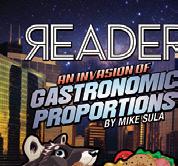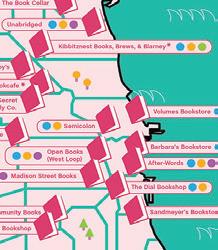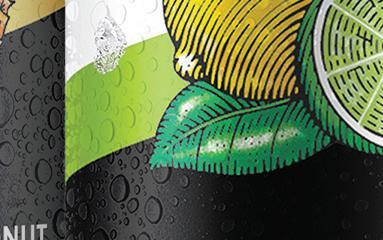Chinatown: the next generation Chinatown: the next generation
This year’s Summer Fair represents a passing of the torch and merging of communities in the historic neighborhood.

 By KAYLA HUYNH 16
By KAYLA HUYNH 16

This year’s Summer Fair represents a passing of the torch and merging of communities in the historic neighborhood.

 By KAYLA HUYNH 16
By KAYLA HUYNH 16
04 Rhodes | Shop Local An ode to trinkets
women organized one of the first successful hunger strikes in an Illinois women’s prison in years.
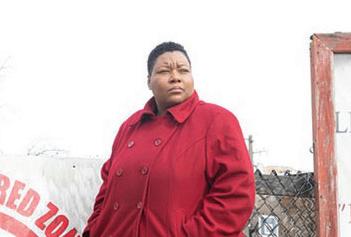
CHICAGO READER | JULY 8, 2021 | VOLUME 50, NUMBER 21
Canal Irreal, Izzy True, Koeosaeme, and more
37 Chicagoans of Note Sacha Mullin, singer-songwriter and backup vocalist extraordinaire
38 Early Warnings Rescheduled concerts and other updated listings
38 Gossip Wolf Rock critic
06 Sula | Feature Waroeng is the midwest’s first Indonesian grocery.

16 Chinatown This year’s Summer Fair represents a passing of the torch and merging of communities in the historic neighborhood.

19 Portraits Juliet Art House in Pilsen introduces the work of Rebecca Baruc.
20 @frida_kahlo Are “blockbuster” art shows alienating people who just want to look at art?
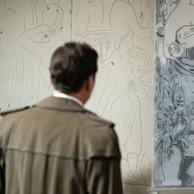
08 Joravsky | Politics One le ie’s complicated relationship with the Chicago Tribune

10 Isaacs | Culture Monica Brown’s art at ARC Gallery traces ancestral legacies.
12 Justice A er a sewage flood at Logan Correctional Center, three
21 Reviews Art by Hyun Jung Jun at Goldfinch in East Garfield Park and a new exhibition at the MCA surveys over 60 years of Chicago cartoonists.
24 Virtual Cabaret Tony Grayson finds surreal joy in Eschaton
26 Dance Tap Secret! offers pure escapism.
THIS WEEK ON CHICAGOREADER.COM
A double-digit entrance fee at a Rogers Park pride festival violated city rules.

28 Movies of Note Good on Paper is a smart take on modern love, The Tomorrow War is a cathartic summer action film, and Tove is a beautiful portrait of desire and despair.
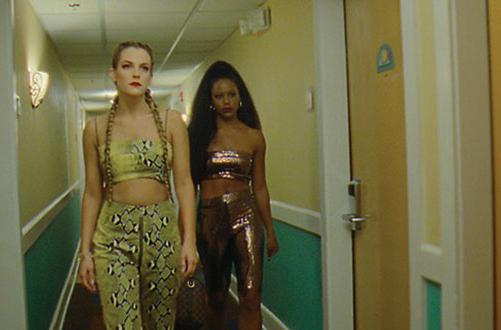
30 Feature No More Heroes are building the future of Chicago rap.
Jessica Hopper publishes a hugely expanded edition of her first book, Bryan Away (aka Elliot Korte) drops an album of lush folk-pop, and an animated footwork film joins the projections on the Merchandise Mart.
40 Savage Love Dan Savage answers questions from “Sack Lunch,” an online hangout for Magnum Lovecast subscribers
45 Jobs
46 Apartments & Spaces
46 Marketplace
TO CONTACT ANY READER EMPLOYEE, E-MAIL: (FIRST INITIAL)(LAST NAME) @CHICAGOREADER.COM
PUBLISHER AND PRESIDENT TRACY BAIM PUBLISHER AND EDITOR IN CHIEF KAREN HAWKINS EDITOR IN CHIEF SUJAY KUMAR MANAGING EDITOR BRIANNA WELLEN PRODUCTION MANAGER KIRK WILLIAMSON GRAPHIC DESIGNER AMBER HUFF MUSIC EDITOR PHILIP MONTORO THEATER AND DANCE EDITOR KERRY REID INTERIM CULTURE EDITOR SALEM COLLO-JULIN ASSOCIATE EDITOR JAMIE LUDWIG SENIOR WRITERS MAYA DUKMASOVA, LEOR GALIL, DEANNA ISAACS, BEN JORAVSKY, MIKE SULA STAFF WRITER ADAM M. RHODES EDITORIAL ASSOCIATE TARYN ALLEN
DIRECTOR OF DIGITAL JOHN DUNLEVY SOCIAL MEDIA COORDINATOR JANAYA GREENE
STRATEGIC INNOVATION DIRECTOR MARIAH NEUROTH DEVELOPMENT AND MARKETING ASSOCIATE CHINYERE FARR-DOUGLAS MEDIA PARTNERSHIPS COORDINATOR YAZMIN DOMINGUEZ EXECUTIVE ASSISTANT SANDRA L. KLEIN MEDIA PARTNERSHIPS AND DEVELOPMENT ADVISOR ABHIMANYU CHANDRA
ADVERTISING
312-392-2970, ADS@CHICAGOREADER.COM
CLASSIFIEDS:
CLASSIFIED-ADS@CHICAGOREADER.COM
VICE PRESIDENT OF SALES AMY MATHENY SALES DIRECTOR AMBER NETTLES SENIOR ACCOUNT REPRESENTATIVES LENI MANAA-HOPPENWORTH, TED PIEKARZ, WILL ROGERS, LISA SOLOMON
34 Shows and Records of Note Previews of concerts including Sistazz of the Nitty Gritty, Joe Pratt & the Source One Band, and Devin Shaffer, plus reviews of releases by

Lightfoot goes where even Rahm and Daley didn’t go with her City Council attack on Alderwoman Taylor, writes Ben Joravsky.
Zola challenges mainstream thinking about sex work.
NATIONAL ADVERTISING VOICE MEDIA GROUP 1-888-278-9866 VMGADVERTISING.COM
JOE LARKIN AND SUE BELAIR
DISTRIBUTION CONCERNS distributionissues@chicagoreader.com
312-392-2970
CHICAGO READER L3C BOARD PRESIDENT DOROTHY R. LEAVELL TREASURER EILEEN RHODES AT-LARGE SLADJANA VUCKOVIC
READER INSTITUTE FOR COMMUNITY JOURNALISM, INC.
CHAIRWOMAN EILEEN RHODES TREASURER CAROL BELL DIRECTORS ALISON CUDDY, VANESSA FERNANDEZ, KIM L. HUNT, JACKIE KAPLAN-PERKINS, DOROTHY R. LEAVELL, SLADJANA VUCKOVIC
READER (ISSN 1096-6919) IS PUBLISHED BIWEEKLY BY CHICAGO READER L3C 2930 S. MICHIGAN, SUITE 102 CHICAGO, IL 60616 312-392-2934, CHICAGOREADER.COM
COPYRIGHT © 2021 CHICAGO READER PERIODICAL POSTAGE PAID AT CHICAGO, IL ALL RIGHTS RESERVED. CHICAGO READER, READER, AND REVERSED R: REGISTERED TRADEMARKS ®








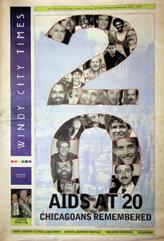
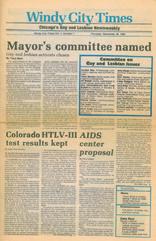
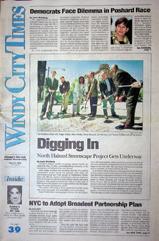
FOURSIDED CARD & GIFT
5061 N. Clark and 2958 N. Clark, foursided.com THE SILVER ROOM
1506 E. 53 rd, thesilverroom.com More links at chicagoreader.com/chicago/city-life.
I want it all. COURTESY OF ANDERSONVILLE GALLERIA in Hyde Park, and the Swap-O-Rama flea market in Back of the Yards.

What I love the most about buying silly, sometimes truthfully stupid trinkets is not the acquisition itself. It’s the hunt. It’s the journey and not the destination, friends.
There’s something so addicting about meandering around a store when something catches your eye. It stops you in your tracks, arrests your breath. Time slows down around me. It might have something to do with my propensity to shop stoned, but I digress—it’s a great time. A good find will make my day, put a pep in my step, and convince me that this world is worth living in for another day.
Minimalism, living with less, Kondo-ing. Our culture values simplicity in a home, where walls are decorated with only a few works of art, where tables are free of clutter, and countertops are bare. That may be what wary visitors to my house are thinking: by defying the cultural norms of neatness, order, and peace, is my friend Adam chaotic, messy, and unclean?
By ADAM M. RHODES“Wow, you have a lot of stu ” is such a common refrain from first-timers visiting my apartment that I might get it tattooed. It’s always dripping with hesitation and concern. “Am I about to walk into a hoarder house?” is what I hear in the spaces between the words. But I take that wry observation as the highest of compliments.
Yes, I do have a lot of stu . Thank you for noticing!
Nearly everyone I know spent the first parts of pandemic lockdown Kondo-ing the hell out of their apartment. I did the opposite. I told myself that if I was going to stare at my apartment’s heather-gray walls for the rest of eternity, I better make sure I like staring at them. (Side note: Heather Gray is an incredible
drag name.)
With walls bedazzled with shelves and artwork I’d part with not even in death, my maximalism has cocooned me during the pandemic. To distract myself from the very real fear of friends and family dying, I splurged on silly shit that brought some joy into my home, albeit briefly—like an elf figurine that smiles a little too coyly or a pair of penis-shaped candles.
But my tchotchke trove began far before COVID-19. When I lived in New York City, I worked in Chelsea near a Danish store called Flying Tiger Copenhagen, which can only be described as a store that sells both the most and least useful household items possible. I bought my dad a $5 mini drone for Christmas
there and picked up a ceramic cactus tray for myself that now holds the backs of my enamel pins. The kitchen section is the most useful part of the store, however. That’s where I found a set of chopsticks, a teapot, and flower vases that all eventually found their way into my home.
My dragon’s hoard has grown the most since I moved to Chicago. Stores like the Andersonville Galleria and its neighbors Foursided and Woolly Mammoth, and Logan Square’s Sideshow Gallery are mainstays on my foraging path. And after asking readers and friends for suggestions of similar treasure troves, I have a list of favorites that I’m eager to visit: Rosebud’s Reflections Jewelry and Accessories in Chatham, Bookie’s in Beverly, the Silver Room
Fear not! There is organized chaos in my clutter. Any collector worth their salt would say the same. The candles, mini cauldron, and collections of skulls of various materials and sizes are arranged on the altar above my TV purposefully. The preserved death’s-head hawkmoth and Tom of Finland print are next to each other on my wall for a reason. The papel picado garland above my bed is intentional. Maximalism, cluttercore, whatever you want to call it, I’m a collector.
I feel at home among the clutter, with mere inches between picture frames, prints, shelves, and knicknacks. Each item, each print, each doodad and whatsit has a story, a memory, and a place. Some, like the penis candles, are just there to create intrigue and a good laugh. Other items, like the small lucky cat figurine I bought on my first trip to San Francisco, or the Salvador Dali prayer candle that was my first desk decoration at my first job out of college, remind me of where I’ve been, how far I’ve come, and the places I have yet to go.
I love all my treasures because they honor my journey, despite the space they may take up on my walls and countertops. And I can’t wait to keep going and collect more. v
@byadamrhodes

 By MIKE SULA
By MIKE SULA
Tasya Hardono thought hard about where to locate the midwest’s first and only Indonesian grocery store.

“Indonesian people like to hang out in Woodfield Mall, Mitsuwa, and there is one restaurant called Asian Noodle [House]. So I open the map.”
She found the right spot in a former cell phone store in a Schaumburg strip mall, just a few minutes southwest of that pan-Asian restaurant with a handful of Malaysian dishes on the menu. Until recently, Chicago’s Indonesian community had no place of its own when it comes to retail comestibles—or restaurants. Notwithstanding the very active but once again itinerant Indo-Cajun Bumbu Roux, that began to change when chef John Avila opened Minahasa at Revival Food Hall last January.
Like so many chefs I’ve covered during the pandemic, Avila, a former sous chef at Gibsons Italia, took advantage of his idle time to pivot
to something personal, cooking food inspired by his mother Betty’s hometown in North Sulawesi. When I wrote about him in November he was still taking orders via Instagram but dreaming about opening a brick-and-mortar location. In early January he and Betty took a big half step, settling into Revival. It was as busy as a crypt, but he still felt like he was in over his head. He knew how to run a kitchen, but, “Technically I didn’t know how to run my business,” he says.
Meanwhile, Hardono was bouncing back from an especially di cult year. She was born in Jakarta and for the better part of the last 25 years she’s worked in middle management at fast-casual chain restaurants in the northern suburbs, moving up from server to manager at Panda Express, and going on to oversee multiple KFC/Taco Bell locations. Just before COVID-19, she was diagnosed with breast cancer.
She began treatment, but over the summer her FMLA benefits ran out, and she lost her job as a training specialist for Panera Bread.
“Everything I thought I had was crushed,” she says. But then she thought, “This won’t be forever.”
She underwent surgery, chemo, and radiation, and in January her doctor gave her a clean bill of health. She began planning her next move. “My husband said, ‘Why don’t you start something that you always wanted to do?’ All those years I’m taking care of other people’s money. I started looking for a restaurant for sale.”
She wanted to open an Indonesian restaurant in particular. She knew cooks in the community who sold traditional homemade food to friends and family in quantity, but nobody who knew how to run a professional kitchen.
“I was just sitting at that computer wondering what’s new in Chicago during the pandemic,”
when she read about Avila in the Reader. She realized Betty was a friend of her mom’s. “We knew Auntie Betty makes a good egg roll.”
On Minahasa’s second day in business at Revival, she and her husband placed an order for ayam tuturuga and beef rendang and drove into the city. “I introduced myself. I said, ‘John, who is working with you?’ ‘Just me and my mom.’ I said, ‘You must be kidding. How can I help?’”
She showed up an hour before opening the next morning and began pitching in—and pitching. “The next day she was like ‘I want to invest,’” says Avila. “‘I can help you run the financial part and run the front.’ My mom said, ‘We can trust her.’” Hardono took orders, helped with opening and closing, and generally took care of the front of the house as tra c in the food hall gradually began to increase.
Before last month, if you suddenly found yourself in need of any of the fundamental ingredients of Indonesian cuisine, such as candlenuts, sambal, or the textural universe of crisps and crackers that serve as snacks and accompaniments, you might get lucky at one of the city’s Vietnamese supermarkets. But ever since Golden Pacific Market closed in 2017, if you were, say, Grant Achatz in search of kluwak kupas, it was no dice, chef. Hardono noticed that when Avila needed Indonesian shrimp paste or kecap, he’d often strike out on Argyle Street. And when he’d order items wholesale from importers on the coasts, he’d get overcharged.
A sales rep from an LA-based importer recognized their dilemma and suggested that Hardono cut out the middlemen and establish a midwestern retail hub for Indonesian imports, which would save on shipping and wholesale upcharges for the restaurant. At nearly the same time the Indonesian consul general stopped by Minahasa for banana fritters and suggested the very same thing.

The partners shook hands on the idea and in June, after a frenetic and sometimes harrowing build-out, Hardono, Avila, and a third partner threw a grand opening for Waroeng two days after the first of five pallets of merchandise tipped over in transit, leaking sambal and flavored children’s milk on a trucking company’s warehouse floor.
But Hardono’s husband Hardy
in
2217 W. Schaumburg Rd., Schaumburg
(833 ) 927- 6364
@waroeng_chicago on Instagram
in logistics for a packaging company, and he knew how to ensure the rest of the stock would arrive in time. Family and friends chipped in to stock the shelves, input point of sale codes, and set up a karaoke system for the ribbon cutting. The consul general showed up, as did the mayor of Schaumburg, along with a number of other dignitaries. Waroeng, which is a word for a small village general store, was open for business.
Hardono, who divides her time between Minahasa and the store, stocks close to 600 different items. That includes some 25 varieties of chips and crackers, (shrimp, tapioca, squid, etc.), 20 di erent kinds of sambal, and dozens of premade spice mixes and pastes for quick and easy versions of dishes like rendang, soto ayam, nasi goreng, or bumbu rawon—plus most of the raw ingredients you need to make them from scratch (including kluwak kupas).
Last month she handed me a rarely unblemished, fuschia-colored rambutan from one of the cases she’d picked out herself from her Florida-based fruit supplier, and she led me on a rapid-fire tour of the store’s two narrow aisles.
There’s the full spectrum of Mie Sedaap instant noodles, including the exceedingly uncommon spicy rendang flavor with green chili; sweet and hot varieties of emping, crackers made from the belinjo nut; tempeh starter; whole candlenuts; and peanutty pastes for gado gado. There’s a section for handicrafts and topical remedies; tea and coffee; and a dizzying aisle full of snacks from which she plucked and pressed on me a bag of ghost
pepper cassava chips and another filled with keripik usus—crunchy, sweet-salty twists of salted egg-flavored chicken intestine. (They were snacktastic).
People have come from Rockford, Indiana, Michigan, Wisconsin, and Iowa to shop for these things. Two weeks ago two guys loaded up their trunk with $600 worth of goods and headed back to Nebraska. Each weekend the store o ers a small menu of prepared foods for carryout, such as last week’s martabak telor (stu ed beef pancakes), tahu isi (stu ed tofu), roti sobek coklat (chocolate sweet buns), and the pickled vegetable medley acar, kind of like Indonesian giardiniera.
Meanwhile, Hardono’s buying power allows her to supply Minahasa with staples like terasi shrimp paste from northern Java at import prices, skipping the wholesale markup. “That’s where the best shrimp comes from,” she says.
She’s also able to source rare and hard-toget items like roa, anchovies fished o North Sulawesi that Avila processes into sambal; and the smoked skipjack tuna he needs for the grilled banana-leaf-wrapped coconut sticky rice cakes lalampa.
It’s going to be fun to watch him build an ever wider repertoire of uncommon Indonesian dishes. “A lot of stuff I’ve never seen because I’m an Indonesian American,” he says.
“So I’m glad I have her around to broaden my horizons. She’s introducing me to new ingredients I’ve never worked with. It’s kind of a playground for me.” v
@MikeSula
LOTS BEGIN TO CLOSE: Tuesday, July 20 at 10:00am CST
LOCATION: 3325 N. Southport Avenue, Chicago, IL 60657

INSPECTION: By Appt. Only. Call Brian Clettenberg at 847.729.3380 or brianc@winternitz.com
Wednesday, July 28, 2021
5:30 - 7:30 pm, with program at 6 pm City Winery - West Loop (1200 W. Randolph)
Program featuring Chicago Reader senior writers

Hors d’oeuvres, wine, beer, soft drinks included Courtesy of City Winery and Haymarket Beer Company
All funds raised will benefit the Reader’s recently established 501(c)(3) nonprofit: Reader Institute for Community Journalism.
• Billiards Hall Memorabilia • (4) Bowling Lanes • (4) Antique Manual Pinsetters
FEATURED EQUIPMENT: Pool Tables • Large Quantity of Pool Balls and Cues
Bowling Balls & Equipment • (2) Historic Mural’s • The Actual Bar, Dating back to 1922!
Barware & Tap Handles
IL Bell Phone Booth (from the Turn of Century)
Winternitz Industrial Auctioneers & Appraisers
For More Info. Contact: Charlie Winternitz, 847.272.0440 or charlie@winternitz.com
Donations can be made online here: https://tinyurl.com/ReaderLegal or via check made payable to Reader Institute for Community Journalism and mailed to: Chicago Reader, Attn: Chinyere Farr, 2930 S. Michigan Avenue, Suite 102, Chicago, Illinois 60616
Minimum donation: $250 per ticket
Questions? Email tbaim@chicagoreader.com
Listen, as you all know, I think that Mayor Lightfoot should apologize to Alderwoman Jeanette Taylor for the disrespectful way she recently walked across the council floor to chastise her.
newsstand at Main and Chicago.
As far as we were concerned, the Tribune was on the wrong side of every issue.
Just how wrong was not apparent to me until much later—in the early 1980s—when I started covering politics in Chicago. I spent hours going through old clippings in the Municipal Reference Library in City Hall—to study up on all the things that happened in the years before I was alive or paying attention.
Reading those old stories, I couldn’t believe how anti-Black, anti-hippie, pro-war, and pro-Nixon the Tribune was. Not just in their editorials, but even in some of their news coverage.
For instance, they actually championed the o cial version of what happened the night in 1969 when cops killed Fred Hampton and Mark Clark.
If you read the Tribune ’s version, you’d think the Panthers fired at the cops and the cops killed them in self-defense. As opposed to what it really was—a cold-blooded execution sanctioned by the state.
In the 1980s, I started subscribing to the Tribune on the grounds that I needed to read it to understand how Chicago worked. Guess I got to thank them for that. If you want to know how corporate Chicago views the world, read the Tribune’s editorials.
 By BEN JORAVSKY
By BEN JORAVSKY
As one great Tribune journalist after another took the hedge fund’s buyout and walked out the door, I found myself facing a great decision . . .
Do I continue my daily subscription to the Chicago Tribune?
I realize this is the quintessential baby boomer dilemma. Millennials must be laughing at the notion that someone subscribes to a newspaper, much less agonizes over giving up that subscription.
Actually, youngsters, I subscribe to three daily papers—the Tribune, Sun-Times, and the New York Times. They’re tossed on my porch every morning by a delivery man who gets up way earlier than I do—that’s for sure.
My love for the Sun-Times goes back to the
1960s when I was a kid growing up in Evanston. I read its sports pages before I went to school.
But the Tribune? Well, that’s a more complicated relationship.
I grew up in a family of New Deal Democrats. As a collective unit, we hated the Tribune. As we saw it, the Tribune was owned by mindlessly flag-waving, America-love-it-or-leave-it, right-wing Republicans. It was like that damn paper was put on earth to torment us. Did we subscribe to the Tribune? Hell, no. Wouldn’t be caught dead with that rightwing rag in our house. We got the Sun-Times home-delivered in the morning, the Daily News in the afternoon, and on her way to work my mom bought the New York Times at the
More tax breaks for the rich. Less social programs for the poor. Stop coddling criminals. Break unions. Especially the teachers union. Make it harder to sue corporations. Send Republicans to Congress and Springfield, and keep the Daleys in City Hall.
Again, I’m speaking of their editorial voice—not the news coverage, which was balanced. For all their Republicanism, for all their professed disdain for the Democratic machine, they cozied up to the Daleys—daddy and son.
Yes, they endorsed Harold Washington in 1983 when he ran against Bernie Epton, a Republican. But they were so patronizing about it—like they thought they deserved a medal for endorsing a Democrat. Even though, as I said, they’d been endorsing Richard J. Daley for years.
And they were so condescending to Washington when he was mayor. As though they were saying, in so many words: OK Mr. Black Man, you wanted to be mayor so much. Now,
But I must concede Mayor Lightfoot has a point when she says the papers—at least, the Tribune —never made a big deal about the shitty attitudes and bully tactics of Chicago’s white mayors. They helped perpetuate the myth that it takes a mean-tempered Boss to keep Chicago from turning into Detroit. It’s a myth we struggle with to this day.
And yet . . .
I despise what the new owner—Alden Global Capital—is doing to the Tribune by pushing so many talented journalists out the door. I don’t want the paper to die. In many ways, its news coverage is outstanding—especially in City Hall and on the environment. Those editorials are still an abomination, but they brought in a few liberals to diversify the opinion page. Most Tribune staffers weren’t even around back in the bad old days of the Tribune’s rightwing ragdom. So, I really want to support the writers and editors still working there.
Especially since we’re in the same union. That’s right. Colonel McCormick must be turning in his grave because the Tribune’s editorial sta is unionized. And they’re a pretty courageous bunch at that.
But here’s the problem . . .
That new owner is looking to take advantage of my loyalties.
Until recently, my subscription helped support people whose work I admired—like Eric Zorn, Mary Schmich, Dahleen Glanton, Heidi Stevens, or Shannon Ryan. And so forth.
But Alden essentially bribed these higher-paid writers into leaving.
And now more of my subscription will be going to Alden. I mean, it’s not like they’re going to take the money they saved on salaries to give remaining staffers a raise. Or to hire new staffers. Or cut subscription costs. Or whatever.
No, they’re gonna put that money in their pockets. In short, they’re going to exploit my love for newspapers and my loyalty to the Tribune sta ers to make even more money for themselves. And, people, I don’t know if I want to enable them.
So here I am. Not sure what to do. One way or another, I’m still being tormented by the Tribune.
Ben Joravsky’s Greatest Hits is a collection of profiles and features hand-picked by Ben from his 40 years of writing for the Reader. Each article offers a distinctive portrait of an activist, politician, writer, or sports personality who has left an indelible imprint on Chicago.
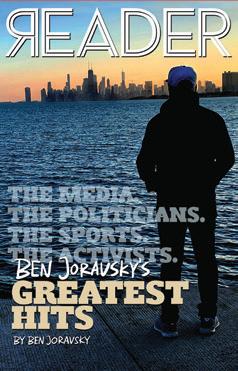

chicagoreader.com/store


We are excited to launch our Chicago Reader Tote Bag
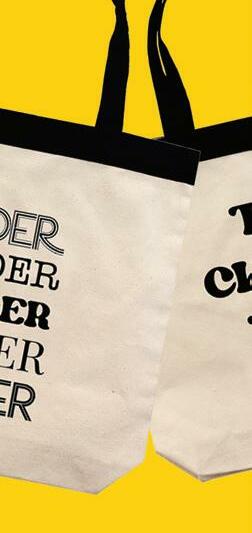

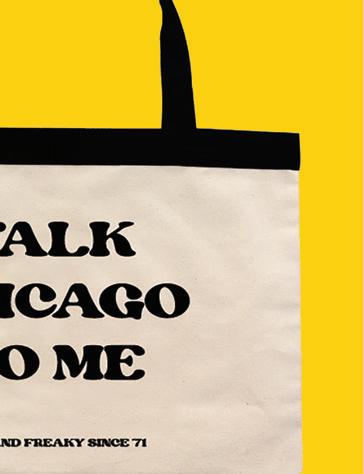

$25 (includes shipping) chicagoreader.com/store
we drove for 18 hours straight. the driver: none of us had met before. one of your friends, that vague line of distinction made him eligible to carry us like firearms in a white van across the fragile state lines from New York to Georgia. i kept trying to get the luminescence of the outside to wrap around my wrists, a sly boy handcuffed with light. when we finally met with you, I had as many questions as teeth. you hugged hard enough to exorcise the affair you accused Mom of having out of me. i couldn’t help but think i deserved more for my patience than a large plate of saltfish and some boiled dumplings, than a collection of stories and evidence that you could be anyone’s father, but mine.
Poem curated by Xandria Phillips: Xandria Phillips is the author of HULL (Nightboat Books, 2019), and the recipient of a Whiting Award. They have received fellowships from Brown University, Oberlin College, and The Wisconsin Institute for Creative Writing, and are the 20212023 Poetry Fellow at the Center For African American Poetry and Poetics.
A biweekly series curated by the Chicago Reader and sponsored by the Poetry Foundation.




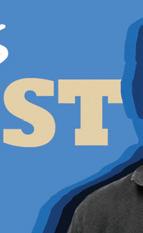











Teen Poetry Labs (Online): July 2021
Participants will read and discuss a wide range of contemporary poems, and receive guidance in the creation of their own work.
Dates for different grades 6–8 and 9–12 in July 2021.
Space is limited & registration is required
Find dates and register at PoetryFoundation.Org/Events
Memory is an abstraction. It holds our entire history, but how much of that is our ‘real’ story? And what stories do we tell ourselves about this story?
—Monica J. Brown, Artist’s StatementIf you visited the Reader office between 1992 and 2008, when it was located on Illinois Street above the busy Star of Siam restaurant, you’re likely to have met Monica J. Brown. During those years, Brown had the job of handling the crowds who made their way up to the Reader’s second-floor reception counter, mostly to turn in ads for the paper’s famously fat classified section.
That was her day job, the one she kept because it left her free at other times to work on her art. Born and raised in Kewanee, Illinois, Brown had come to Chicago after collecting a BFA as a painting major at the Otis College of Art and Design in Los Angeles. She later earned a master’s in interdisciplinary arts
from Columbia College Chicago, adding writing and performance to her tool kit. She was looking for the best way to tell the stories that inspired her solo show of visual work, on display now at ARC Gallery.
“Roots, Branches: Ancestor(s) Stones,” as the show is titled, is a tribute to Brown’s forebears, part of her ongoing mission to honor and connect with the women who came before. So far, she’s been able to trace eight generations of their history, working backwards from successive pairs of daughters and mothers to a still-mysterious woman she calls YOMHN.
It’s an epic mission: YOMHN gave birth to Zilpha in 1830 in North Carolina. After that, four generations were born in Tennessee: Zilpha’s daughter Parthena, in 1861; Parthena’s daughter Ora, in 1891; Ora’s daughter Grace, in 1910; and Grace’s daughter Flora, in 1925. Shortly after Flora’s birth, Grace—with mother, grandmother, and children in tow—left
Tennessee for Kewanee, where Flora’s daughter, Elizabeth, was born in 1947, and where Elizabeth, having married Donald J. Brown, gave birth to Monica J. Brown in 1969.
This story’s been calling Brown since childhood. She told part of it in a one-woman play, Branch and Bough , written while she was in graduate school. The play is a brief encounter with three generations: Ora, Grace, and Flora, each in turn sharing a confidence across an iconic kitchen table. Brown says the writing and performing of it made her realize that “My ancestors are with me; all I had to do was recognize it.” And that the stories of those earlier generations, even when they tell of troubles—betrayals, divorces, the death of children—are a treasure trove of resilience, a source of support.
“There’s power in story,” Brown says: “I think stories can heal.”
The 15 pieces of Brown’s work on the walls
at ARC include three collages that juxtapose vintage photos and intense fields of color. In two of them (both titled I prayed for you before you were born), a woman in an apron, Brown’s great-great-grandmother, stands behind a small child, a granddaughter of three or so. Both faces are blurred—as inexact as memory, Brown said when I asked her about that. But in the first of the two, a circle of vibrant chartreuse puts a spotlight on a point of connection: the woman’s open hands resting, as if to bless, on the head of the child.
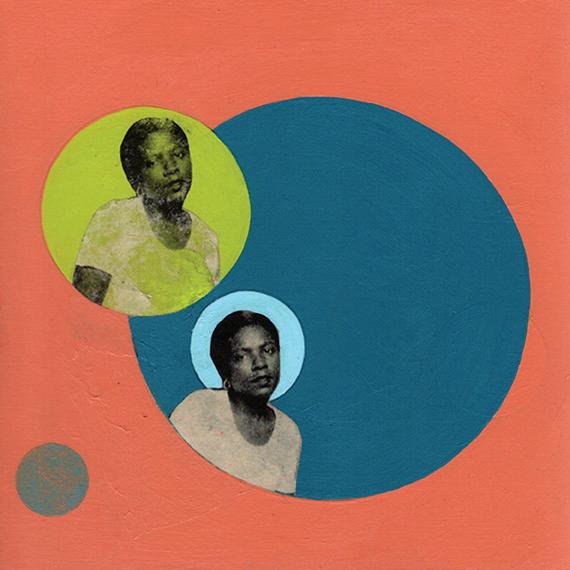
Brown’s next project, already in progress thanks to a DCASE grant, will focus on YOMHN. The name is an acronym (you owe me her name), originally prompted by Brown’s frustration at the lack of records about this predecessor, who may or may not have been a free woman. But now, she says, her search is about something more than that, about understanding “who she was.”
“Not as a victim. We had more than victimization as African Americans. I’m not saying there isn’t something that’s owed. There should be reparations. But I’m saying there’s also something else that’s the reason we are still here, that we still exist, despite all that shit. Circumstances bring to light the character of the person who responds to them.”
These ancestors, including her mother, who died in December, were “strong, determined women,” Brown says. They worked hard, fed anyone who came to their door, and taught their daughters to “give without worrying about receiving.”
A longtime yoga teacher and Thai bodywork practitioner, Brown has nieces and nephews, but no children of her own. That was a choice, she says. “I’m the one who’s supposed to look back and remember, to honor the legacy of the ancestors, to share, and pass down.”

“It doesn’t have to be directly through my womb.”
“Roots, Branches: Ancestor(s) Stones” runs through July 17 at ARC Gallery, 1463 W. Chicago; it’s free. Hours are 2-6 PM Thu-Fri and 12-4 PM Sat-Sun. Info at arcgallery.org.
@DeannaIsaacsStretched out on her bunk at night, arms all akimbo, Sharonda Miller likes to close her eyes and imagine freedom is a train ride home. After 19 years away from her only child, the 41-year-old mother, known for her big jokes and watchful eye, has built countless friendships inside the gates of Logan Correctional Center, Illinois’s largest women’s prison.
Miller pictures the gentle “no thank yous” she will dole out to offers of car rides from those she’s met over the years. Instead, she’ll take the solitude and directness of a fast metal train car cutting through the gold and green fields taking her home, finally, after nearly two decades.
That dream will have to wait. One day at the end of May, there was water everywhere, maybe a foot deep, rushing out of shower drains and toilets, and rising in her unit. “I told my buddies who kept sweeping out the water with a broom that I thought I saw shit balls,” Miller wrote to me sardonically over an electronic message service. “Finally a large turd came up and we all looked in shock at it at the same time.” Her friends darted out of the sewage water. The unit’s gate was shut
and about 40 women were locked in with noxious liquid that would destroy many personal belongings.
The women were eventually moved to vacant units that had not been used for years, one of which was “condemned” according to Miller. In these units there were no phones, no cable WiFi, and no video visits, essentially cutting o the women from communicating with their children and loved ones. Mold, spiders, and maggots were in the sinks. Miller was puzzled. Crammed together and unable to social distance, her anxiety from surviving the COVID-19 pandemic began to rise. She thought Logan Correctional Center had adequate livable space due to the reduction in its population during the pandemic.
The lack of cameras in her temporary unit made her mind tick and creep into dark parts of her past. Miller, like nearly all women at Logan Correctional Center, is a survivor of gender violence. She was sexually assaulted as a child in the foster care system and just last year, during the pandemic, she claims a correctional o cer attacked and physically assaulted her, nearly breaking her arm. A 2017-2018 survey conducted by the University of Chicago School of Social Service Admin-
istration in partnership with the Women’s Justice Institute found that 99 percent of the women incarcerated at Logan Correctional Center have experienced physical, emotional, or sexual abuse at some point in their lives. More than half the respondents, 60 percent, like Miller, had experienced abuse as a child.
The next day, prison officials said they needed volunteers to clean up the old housing unit. Miller’s two friends were given watered-down bleach to clean out a room that reeked of feces. They reported back that nothing was fi xed—there were still only two working toilets and sinks for more than 40 women.
Fearing what they had been exposed to in the water, Miller says the women in her unit asked for hepatitis A and B shots. Prison sta said the shots wouldn’t help after exposure and that they should have received them when they arrived to serve time. A day later, they were given a memo from prison staff that said they could ask for vaccinations, according to Miller.
Stuck in a condemned unit, Miller and two friends began to plot a way out for all the women on the tier. For nearly two decades, Miller has operated as a strategic prison or-
ganizer and an uno cial “jailhouse lawyer,” assisting hundreds of women in navigating clemency petitions, fi ling appeals, and deciphering legal paperwork from law libraries. She even taught women how to vote, despite never having voted herself. The three women asked a correctional officer to help; he said he would see what he could do. After hearing nothing for days, they wrote a shift commander who said he would check into it; again they didn’t hear anything. By June 4, Miller says that she and her co-organizers wrote a letter to Logan Correctional Center officials asking them to move the group to functional, clean housing. (While Miller was comfortable sharing her name on record, her co-organizers asked to not be named in this article out of fears of retribution.)
Another three days passed and repairs were still not done. On June 7, the hunger strike began. “Fasting felt necessary, mind over matter,” Miller says. “Even if death was to come, those were the chances we were willing to take.” In just two days, they ended the strike because repairs were promised and prison officials assured the group they would be moved again if needed. While new sinks were installed, Miller says that women
have stu ed clothes at the base of the sinks to stop them from leaking and that mold is still visible in the unit. She says that Logan Correctional Center sta held a town hall on June 10 where sta also questioned whether it was safe for the incarcerated women to live there.
Lindsey Hess, a spokeswoman for the Illinois Department of Corrections, confi rmed in an e-mailed statement that the three women went on a hunger strike in early June due to plumbing issues that began on May 29. Hess says that facility staff identified plumbing issues and a leaky pipe in the basement of housing unit seven, and out of precaution women from the unit were moved for repairs.
“If they can’t properly house inmates then they should release them,” Miller says of the facility. “The longer-term inmates get exposed to these conditions when they should be released because they have already been rehabilitated.”
Even before the sewage flood, Logan Correctional Center was quite literally falling apart, like many of Illinois’s aging prison facilities. Opponents see it as a carceral money pit. Reformers want Logan shuttered and the state to invest in more community-based carceral solutions; abolitionist organizations, like Moms United Against Violence and Incarceration, want the women housed there to be freed. No one interviewed for this story was sure what exactly the state’s long-term vision for Logan Correctional Center is.
The Lincoln, Illinois, facility, a 150-acre rust-colored brick prison, is located some 30 miles north of Springfield and houses just over 1,000 women currently, according to the Illinois Department of Corrections website. Over the past ten years, Illinois has spent $1.4 billion on its women’s prison and parole system. Logan Correctional Center alone costs the state $60 million to operate each year, which is over 70 percent of the Illinois Department of Corrections Women’s Division’s operational costs. Illinois Department of Corrections requested $24.9 million for repairs and renovations at the facility in 2022.
After nearly two decades as a men’s facility, Logan Correctional Center was “hastily converted” to a women’s prison in 2013 in “an ill-conceived plan” to consolidate the women’s prison population and in turn address the state’s budget shortfall at the time, according to a recent Women’s Justice Institute report. The facility has since fallen into deep disrepair, including mold, falling
ceilings, rodent and insect infestation, and significant plumbing issues that have caused water supply shutdowns. Miller also says that birds “dip and dive overhead” while incarcerated people eat in the kitchen and fat raccoons that live in the ceilings “have gnawed through the roof making holes large enough to fall through and attack.” The
The trio of mothers are friends who bonded over the past decade in Mom and Me programs and summer camps with their kids at the now-shuttered Dwight Correctional Center.
Antu’Nesha Taylor, or “Doola,” was just four years old when Miller was sentenced to 30 years in the Illinois Department of Cor-

of society,” Judge Speroni told Miller at the time of the trial. “Of course, it is still a matter of your choice.”
Supporters argue that Miller was criminalized for defending herself against rape and punished for her act to survive gender violence. Since November 2020, her clemency petition to reduce her sentence to time served has sat on Governor J.B. Pritzker’s desk, awaiting his judgment.
All three women are required to serve the full lengths of their sentences due to the state’s Truth In Sentencing law, which in 1995 restricted people’s ability to earn time off their sentences if convicted of certain crimes, including murder. “We are here for the long haul due to our sentences, so we are ‘permanent fixtures’ to these conditions,” Miller explains. “So we had to act.” Fighting their deteriorating living conditions doesn’t come without sacrifice. “It literally drains you of all energy and we are on clemencies or appeals and need our energy to focus on that ‘good fi ght,’” she writes.
The stakes of organizing in prison are often higher for incarcerated women than men. They can face write-ups that culminate in solitary confinement and the loss of privileges, including visiting with their kids, advocates say. About seven out of ten women in Illinois prisons are mothers, and most of them were their children’s primary caregivers before they were incarcerated, according to a 2016 report by the National Resource Center on Justice Involved Women (NRCJIW) and the Women’s Justice Institute.
plumbing has always been faulty on a major scale and there’s no air conditioning in the heat of balmy Illinois summers, she adds.
“People hear ‘prison’ and think we deserve less than human treatment as is,” says Miller. “So it’s nearly impossible to receive any type of compassion or assistance in regards to our lives and issues.”
Inspired by Mumia Abu-Jamal, Assata Shakur, Angela Davis, and the San Quentin Six, to name a few political activists, it wasn’t the group’s fi rst time organizing. Miller participated in a commissary boycott at a federal prison in Tallahassee in 2004. One of the other strikers says she once missed 24 meals in a hunger strike before prison o cials came to talk to her.
rections. In 2003, a Williamson County jury convicted Miller of fi rst-degree murder in the death of Alexander County Assistant State’s Attorney Steven Jett. Miller, who was then in her early 20s at the time, worried that Jett had HIV and broke o their sexual relationship, yet the pair remained friends.
Miller claims that Jett attacked and attempted to rape her at gunpoint in his home one night while her daughter was present, and in an attempt to defend herself she fi red a shot in the dark that killed Jett. Then-Williamson County State’s Attorney Charles Garnati had asked then-Judge John Speroni to give Miller the maximum 60 years in prison. “I think you have the potential for rehabilitation and to be a productive member
The three women strategized that unlike a boycott of the commissary or other organizing tactics they’d participated in over the years, a hunger strike was less likely to receive punishment from prison officials. Advocates interviewed for this story say the hunger strike at Logan Correctional Center was one of the fi rst successful group hunger strike e orts in an Illinois women’s prison in years, or perhaps ever. It pushed back against the notion that women don’t organize in prison, they say, a misconception in part due to a lack of media coverage and, at times, the fascination of the public.
“Women in prison are either the powerless victims or they’re conniving, manipulative people who are out to get something for themselves. And what we cannot conceive of are people who are actually savvy, smart organizers and strategists. You don’t get to be both,” says Holly Krig of Moms United
continued from 13
Against Violence and Incarceration. “The state has no category of survivor, nor prison organizer.”
The organizing and resistance of incarcerated women is in part how they care for one another. “All these sort of big and small ways that people resist isn’t very well documented,” says Krig. “And also the way that women care for one another just generally isn’t valued very highly in society.”


Victoria Law is a prison abolitionist and writer who in 2009 wrote Resistance Behind Bars: The Struggles of Incarcerated Women “We have this idea that resistance and organizing need to look a certain way. And when things don’t end, when actions don’t conform to that way, that preconceived notion, then we dismiss it as ‘Oh, people are not organizing.’ When in reality, people in prison are resisting and organizing all the time.” She says this often starts with identifying a problem and then figuring out how to support each other through that problem. It can be as simple as women in solitary confi nement talking through the ventilation system to warn one another when they’re on the toilet, getting dressed, or changing their pad or tampon, that a guard is coming.
“That is like a very simple form of resistance that nobody ever thinks of, because this is similar to the way that we don’t think of the whisper network about bad bosses or people in a position of power that abuse their authority to sexually harass and abuse women as a type of resistance,” Law says. “If you think about it, if people are sharing that information, that in itself is a form of resistance, which might lead to something larger and more collectively organized, such as fi ling a lawsuit or trying to get a certain guard o the unit.”
Organizing in Illinois women’s prisons is a lineage that Miller hopes to soon carry with her beyond her sentence. “Once I’m free, I will be better positioned to help other incarcerated women like those ladies before me who have not forgotten the path traveled and are reaching back,” she writes.
Until that day comes, if it does, Miller likes to dream of what it feels like to be free. Her mind softens and savors what she imagines knocking on the front door will sound like when her 23-year-old daughter appears, holding Miller’s grandson in the crook of her arm, fi nally welcoming her mother home.
Amber Nettles joined the Reader in August 2020 and quickly dug her heels in to lead our sales department through a turbulent period when much of Chicago was still shuttered due to the pandemic. Born on St. Patrick’s Day, Amber is a Pisces with Sagittarius rising and a moon in Taurus—an astrological combination that might explain how she developed such a wide range of interests and skills. Raised in Hampton, Virginia, she attended Christopher Newport University, and then worked in newspapers and radio for more than ten years. In 2014, she took an improv class and fell in love with comedy, and she began devoting her nights to class or performing on stage. Amber moved to Chicago in 2017, spent some time freelancing and volunteering, and worked at the Chicago Tribune before she came to the Reader. Amber’s favorite spots in the city include the 606 and cozy neighborhood standbys such as The Boiler Room, Webster’s Wine Bar, The Spice Room, and Taqueria Moran. She can also be found on local stages, performing improv, storytelling, and producing shows. In addition to comedy, Amber enjoys taking photos of her rescue cat Phantom and watching television—a passion that she channeled into a podcast titled “Will it Binge?” during the pandemic. Amber’s love of art and communication serve her well at the Reader, where she says she’s motivated by the paper’s dedication to its audience. “Joining the Reader meant I was helping to support an institution I believe in, one in which I hope I can make a di erence,” she says. “I’m proud and honored to be a member of a diverse management team. Additionally, I like that I can dye my hair purple and not worry about getting fired.”
Twitter: @amberlnettles • IG: @phantomcatchicago

One night in the not-too-distant past, the stars aligned over the Illinois Masonic Medical Center, and a baby was born. That baby grew up to be the visual artist, music enthusiast, writer, funny lady, and allaround amazing human we know as our listings coordinator and interim culture editor Salem Collo-Julin. Raised in Smith Park and Elmhurst, Salem has lived in Philadelphia, but spent most of her life in various Chicago neighborhoods, so each of her favorite local spots (a short list includes Buckingham Fountain, Skylark, the former Checkerboard Lounge and Velvet Lounge sites, and a spot on Lake Shore Drive where she narrowly avoided an accident) are connected with special memories. Salem brings her love for Chicago to the Reader, where in addition to her editorial and listings duties, she writes a weekly column of event recommendations that’s so informative and fun we no longer make any plans without consulting it first.
“The Reader has been a presence in my life for my entire life, and it’s a thrill to help bring everything I love about my hometown to the entire world,” she says. “My friends tell me that I’ve found the perfect job for me and I have to agree with them.” When she’s not out and about herself, Salem enjoys hanging out with her large network of family members, her chosen family, her dog Ray Ray, and her new rescue kitty Bosco. If there was a movie about her life, Salem would like to play herself, “à la Tears and Laughter: The Joan and Melissa Rivers Story,” but she says that since she’s still relatively unknown in Hollywood, the directors would probably try to get Demi Lovato. Either way, the rest of the Reader sta would be at the front of the line on opening night.
Twitter: @hollo • IG: @hollohulo
Tracy Baim President and Co-PublisherReader co-publisher Tracy Baim has Chicago journalism in her blood. Raised in a family of local media professionals on the city’s near south side, Tracy attended Lane Tech High School before earning her Bachelor’s in journalism at Drake University in Des Moines. After graduation she hightailed it back to Chicago, where she’s been a force in media and activism ever since. By the time Tracy joined the Reader in 2018, she’d already cofounded the LGBTQ+ newspaper Windy City Times in 1985, authored or co-authored 12 books on LGBTQ+ history, and led or co-led numerous community initiatives including the 2006 Gay Games and 2013 March on Springfield for Marriage Equality. “Coming to work for a legacy Chicago community media company has been an amazing experience, one complicated by external forces, and internal changes needed to adapt to the ever-changing media and city landscape,” she says. As a Capricorn, Tracy is ambitious and pragmatic by nature, and in 2019 she had the foresight to begin transforming the paper into a nonprofit organization long before anyone could have anticipated the full impact of a global pandemic, or the rollercoaster-like circumstances independent media outlets face as a result. Thanks to Tracy’s leadership with co-publisher Karen Hawkins, our collective ride through it all has had way more ups than downs, and as we sail into the Reader’s 50th anniversary, we have a strong sense that the journey will only get more exciting from here. A voracious reader and sports enthusiast with a special passion for soccer and softball, Tracy lives on the city’s northwest side with her partner of 27 years Jean Albright, her sister Marcy, and her bio-dad Hal. Outside of work, she enjoys walking, spending time downtown, and watching Fire and Red Stars soccer games. In a movie about her life, Tracy would choose Holly Hunter to star in the leading role; the actress already snagged an Oscar nod for playing a television pro in Broadcast News, and with such rich source material as inspiration, there’s no doubt she’d hit it out of the park as our fearless co-publisher.
Twitter/IG: @TracyBaimWCMG • facebook: /tracybaim
As we look forward to our 50th Anniversary on October 1st we celebrate the staff of the Reader who make the paper possible.

100% of Profits go toward Homelessness prevention and assistance programs in Illinois.














SOMETHING
This year’s Summer Fair represents a passing of the torch and merging of communities in the historic neighborhood.
By KAYLA HUYNHOn a May afternoon at the outdoor mall Chinatown Square, a group of Asian grandmas wave their arms and sway their hips in a production of guang chang wu (Chinese square dancing). A line of men begins to form into a dragon dance, and later, a singer wearing face paint performs traditional Chinese opera.
The scene at the Asian heritage month event in Chinatown draws in curious tourists passing by. It also catches the eye of Shifa Zhong, a 24-year-old Bridgeport resident and budding social media influencer.
As two R&B artists take the stage for the
finale, he crouches in front of the act with an iPhone. “Look at this,” he says, pointing at the audience of older adults. “No one here is Gen Z.” Volunteers begin to fold up empty seats in the crowd, and families, who’ve paused a moment to watch, then head straight to Joy Yee for lunch.
Zhong wants people of all ages to see Chinatown for more than just its dumplings and dim sum. On TikTok and Instagram, he shares with his 22,000 followers content ranging from the area’s oldest bakery to friends break dancing in Chinatown Square. With each post, he shows Chinatown through his eyes: a home
to longtime community members and a “playground” for young creatives.
Zhong has become an unofficial voice for the youth of Chinatown through his marketing agency Tian Represent, serving as a bridge between older and newer residents in Bridgeport and Armour Square. Though nearly 50 years separate them in age, Zhong has teamed up with Gene Lee, the “mayor of Chinatown,” to plan the community’s pandemic comeback—a two-day fair featuring local vendors, hip-hop artists, cultural performances, and a Hong Kong-style night market.
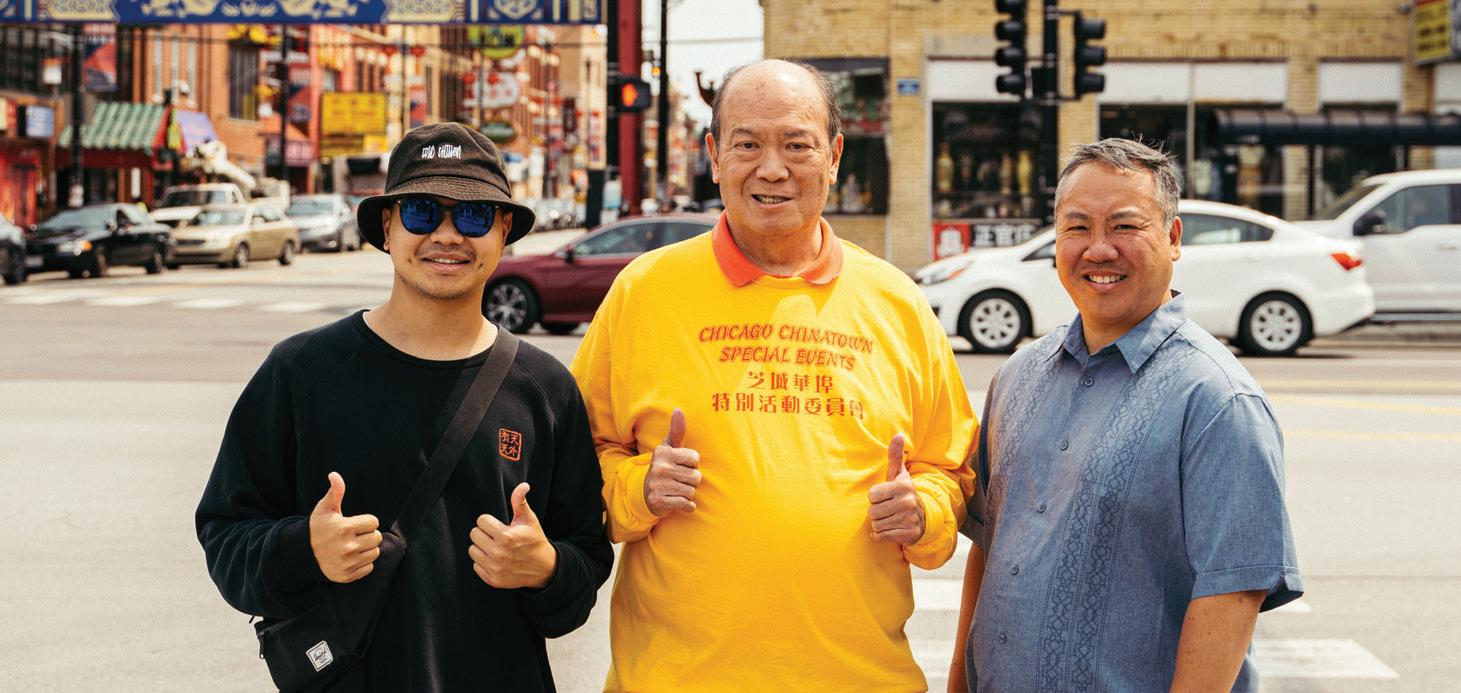
Zhong manages a crew of emerging cre-
atives and entrepreneurs tasked with marketing and coordinating the Summer Fair, which will take over several streets in Chinatown on July 31 to August 1. With less than a month left to plan, they bounce ideas o one another: Where can they place a youth basketball tournament? Where can they fit 30 vendors into one area? Who will provide the alcohol?
This year marks the first time in its 42-year history that the youth have stepped up to coordinate, a sign of growing generational shifts in the community. Meanwhile, Lee oversees organizations that have held the festival for decades, including the Chamber of Commerce
and Chicago Chinatown Special Events.
As the neighborhood ages, older leaders have leaned on the young to preserve Chinatown’s history. In turn, the youth have adapted unique ways of communicating and working with their elders. No party can do it alone.
“Everybody is surprised they started letting the youth take charge now,” Zhong says. “So this is a really new concept.”
Members of the planning committee span three generations, each offering a distinct perspective and area of expertise. Zhong, Jeri Tan, and Christine Huang manage youth messaging and “hyping up people not from the community,” while Tim Brenmark, a board member of the Chinatown Community Foundation, will oversee volunteers. Francis Almeda, owner of Side Practice Co ee on the north side, and Anita Lau, cochair of Chicago Chinatown Special Events, deal with local artists, businesses, and food vendors. Lee and Darryl Tom, the chamber’s president, confirm what can be accomplished within city and Chinatown politics.
Despite having different experiences, beliefs, and expectations of the future for their neighborhood, they’re united in their passion for Chinatown. The result is a fusion of new ideas with Chinatown traditions, reflecting a community that values progress as much as it does heritage.
“We’re doing this because Chinatown is our community,” says Huang, a 24-year-old codirector of the event. “A lot of the younger generations now that grew up around this neighborhood, they moved out of Chinatown or they really don’t care much about Chinatown. But it’s such a great place. People don’t really know much of our culture, which is why we do all these events so we can welcome more people in.”
While the process of organizing an event across generations is challenging, the end product, she says simply, is “going to be lit.”
But understanding why the collaboration is so monumental means understanding the inner workings of Chinatown and the di erences between each generation of residents, Zhong says.
The community is divided into two distinct areas. “Old Chinatown” on Wentworth Avenue south of Cermak, is marked by aging storefronts and the recently
renovated Chinatown Gateway, built in 1975. “New Chinatown” includes development north of Archer Avenue, as well as Chinatown Square mall, where newer, more upscale restaurants and mom-and-pop businesses can be found.
Zhong grew up in China’s modern economic era before moving to Chicago in 2010 at 13 years old—much di erent from Lee, who was born in the U.S. in 1949 during the post-WWII economic recession. Longtime Chinatown leaders, like Lee, approach community organizing in a thrifty and practical way, which often collides with the fast-paced “hustle culture” of today’s younger immigrants and first-generation Americans.
Still, Zhong has learned to interpret his aspirations for Chinatown in a way that makes sense to his elders. Each blueprint for the fair comes with several backup options and every expense must have a justification. Most importantly, Huang says, each deliverable is a chance to prove themselves to Chinatown leaders.
“Other people come in wanting to be paid and claim they have hundreds of contacts when they don’t,” Lee says. “I don’t need to do that with Shifa. He’s not promising me anything. He’s giving me the big picture. He said, ‘I’m looking to raise $150,000.’ Nobody’s ever said that to me with the Summer Fair. We have a di erent outlook, but we’re going to give him a chance.”
Noticing the extent of segregation in Chicago, Zhong brought SoundCloud rappers and breakout producers to Chinatown in 2019 for its first-ever hip-hop festival (Hip Hop in Chinatown), which turned Chinatown Square into a mosh pit of young people from around the city.
“Hip-hop was born in the age of trying to bring oppressed people together,” he says.
“We have to acknowledge that hip-hop is Black and Brown culture. From a community standpoint, I just want to put all the minority cultures together, and then we can build together instead of just hating on each other. I’m the product of a culture that I want to bring to the community.”
After Lee saw Zhong’s success, he invited him to put on the concert again the next year. Though the pandemic eventually put the show on hiatus, Zhong saw an opportunity to work with Chinatown’s uno cial mayor on an even bigger stage. He and his team o ered to help diversify programming for the Summer Fair and to be a translator of the youth.
“I thought, ‘Sure, why not?’” Lee says. “I’m
sure we have a di erence in how we do things, which is fine. I am open to see what you can do. I don’t know who you know, I don’t know how much work you put into this—but if you have what it takes to ring the cash register, you’re worth me paying you.”
To the committee newcomers, no dream seems too ambitious. But first, they need the money to make it happen.
When Huang and Zhong reveal the fair’s potential $130,000 price tag at a recent meeting, Lee and Tom sco in response. “We only have so much money,” Lee says. “We’re not going to take a loan out for this.” Their relationships in the community can help bring in sponsorships and donors, like McDonald’s and Ameristar— but to a tune much less than the crew’s anticipated budget.
“We understand the reality,” Tom says. “It’s a tough year to go really big. But it’s good to have goals.” With the fair drawing nearer, their initial fundraising goals have drifted farther away. The young committee has since lowered their anticipated budget, thinking more realistically to fit the needs of the chamber and Chicago Chinatown Special Events.
In Asian culture, respect and appreciation for elders run deep. Part of the youth’s job means bearing the critical yet supportive nature typical of immigrant parents.
“We’re looking at a Facebook message,” Lee says, as Zhong projects his video announcing the fair onto a TV. Tom offers a prompt correction—it’s actually a TikTok, “but sure, similar.”
The views: more than 100,000.
As the audio plays, Lau reminds Zhong what they talked about at the last meeting. The text should say the youth is one of the leading organizers, not the leading organizer. “Don’t forget the foundation,” she says. “You’re one of us.” Zhong tells her it’s all in the caption.
“Even when you make certain achievements, Asian parents can be really harsh,” he says. “Asian youth don’t really receive empowerment from the older generation.”
The enclave of nearly 90 percent Asians relies heavily on tourism. Some of Chinatown’s most influential movers are business owners and leaders of well-established organizations, like many other communities in Chicago. Owners in Chinatown, however, often pass their stores down to their children, allowing power to remain generational. “There’s the Furama family, the Triple Crown Family, the Chiu Quon family,” Zhong says. “Chinatown used to be run by so many di erent families.”
As a lifelong Chinatown resident, Lee has maintained connections with each business throughout the years. The youth’s vision of the fair, Zhong says, wouldn’t be possible without his blessing and guidance.
“From a Chinese standpoint, it means so much that the mayor of Chinatown is working together with all the generations,” he says. “To work with us, I think it shows how much he cares about the community and that he’s open to the idea of passing down the torch.”
With 40,000 expected visitors, the Summer Fair is Chinatown’s first major event since the city fully reopened at the beginning of June. Zhong says shelter-in-place orders dealt a severe blow to the community, but Chinatown experienced the pandemic’s effects even before COVID-19 became widespread in the U.S.
Duo Tang, a 26-year-old operations manager at the chamber, says anti-Asian sentiment drove tourists and shoppers away early on. The streets of Chinatown began to empty starting last January, he says, when news broke of the country’s first COVID cases. Though there were no confirmed cases in the community at the time, Zhong says headlines highlighting the pandemic’s economic impacts inadvertently made people associate Chinatown with COVID. In the aftermath, businesses saw a 70- to 90-percent decrease in profits.
This year, Summer Fair organizers have expanded the annual event to bring it back to its peak and make up for lost time. “I haven’t really been to the fair ever since I was a young kid,” Huang says. “We needed new ideas for an event that hasn’t changed in the past 40 years they’ve been doing it.”
The plan includes working with vendors and businesses beyond Chinatown—a strategy that initially drew skepticism from the chamber, the foundation, and Chicago Chinatown Special Events.
“Another issue that Chinatown is facing is we’re just fighting each other,” Zhong says. “Chinatown businesses are competitive with each other and they want local money. But they’re not able to keep moving forward by just fighting each other for the same customers. We need to open up more because I see the perception of Chinatown being like an isolated island.”
During past summer fairs, the vendors have typically been limited to Chinatown shops only. Outside stores may mean competition for business owners inside the community, but Lee thinks there’ll be more than enough customers this year for everyone to share.
Almeda, who helps Lau field vendors, says
For the fi rst time in 42 years, a group of youths are now part of the Summer Fest committee, thanks to Shifa Zhong (le ) here with Gene Lee and Darryl Tom. YIJUN PAN FOR CHICAGO READER
continued from 17
the street market will highlight Asian-owned businesses and Black and Brown artists. “We’re looking to bring in creators from all over the city,” he says. “We’re looking to give a voice to and showcase the diverse talent that Chicago has to o er.”
Zhong, who has put together a roster of hiphop artists to perform, hopes the celebration will breathe life back into Chinatown.
“What the general public doesn’t really know is that when we are not doing certain things, it’s not that we don’t want to,” he says. “We have to work a lot within a system. There are so many things that we need to do in the future, but the first step is to get the Chicago community—not just Chinatown—to welcome Chinatown back.”
Chuo Li, an associate professor of landscape architecture at Mississippi State University, has studied the design and structure of Chinatowns across the country. She says Chicago first started advertising Chinatown as a tourist spot, alongside landmarks like the Sears Tower and Navy Pier, in the 70s. As the wealthy moved away, and as new immigrants took their place, “Chinatown came to be seen as a vulnerable and unstable neighborhood,” she says.
This negative perception of Chinatown led to the construction of Chinatown Square mall, a 200,000-square-foot retail and commercial center, which came as the result of a revitalization study in 1980. The study found that “Oriental-looking shopping streets with equally Oriental-looking stores” would bring more tourism to Chinatown, and thus, the giant pagoda and shopping mall was erected. The plan to revitalize the area garnered wide support from private Chinese developers, who prioritized exoticizing the environment over addressing the social needs of the community.
In 1979, Celia and George Cheung, restaurant owners and active community members, held the first Summer Fair to change people’s misconceptions of Chinatown.
“Shifting demographics and the adaptation of immigrant groups to American democratic ideals significantly transformed the social and political composition of Chinatown,” Li writes in an analysis of the enclave. As kinship and community building started to dissolve, a new generation of immigrants then emerged throughout the years, with social organizations led by “well-educated young Chinese Americans’’ taking place. These immigrants began competing with tenured Chinatown
associations as they sought to “build a democratic political structure” in the neighborhood, Li says.

Lee and Fred Roti, a Chinatown-born senator and alderman of the First Ward, took over the programming from the Cheungs in 1989, forming the organization Chicago Chinatown Special Events as a way to further unite the community.
In 1993, the federal government would send Roti to prison for accepting thousands of dollars in bribes, and in a separate 2014 case, Lee would plead guilty to stealing $132,000 of donations from the Summer Fair and the Chicago Dragons Athletic Association.
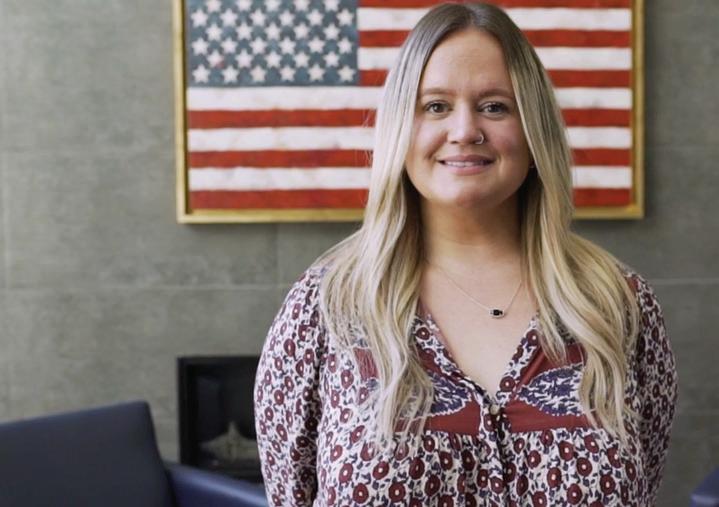
Despite the stain left on his career, Lee, once a deputy chief of sta to former Chicago Mayor Richard Daley, continues to be wellloved in Chinatown. Wherever he goes, everyone seems to know him. “There are no White House secrets,” he says. Lau now handles the organizations’ finances.

“She can tell if you’re talking crap or not,” Lee says over a cup of tea from BBQ King House. “Vendors will take advantage of people who they know are fresh meat. But you don’t make an enemy of her because she doesn’t forget anything.”
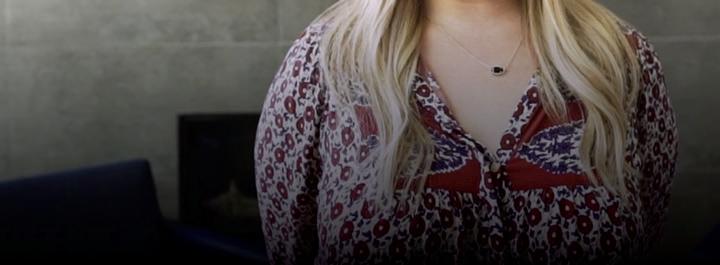
At the meeting, Lau shu es between tasks, working with Huang to incorporate the young committee’s plans with the chamber’s. She compares her hard copy of the organization’s scheduled programming—acts secured through decades of working in the community—to the crew’s digital list of DJs, rappers, and hip-hop dancers who’ve been chosen to perform.
By day, Chinatown will showcase the sights and sounds of Asian culture, including dragon and lion dance processions, traditional singers, and martial artists. By night, the Square will turn into a market and hip-hop concert.
The affair is represented in a flier Zhong presents to the board: an illustration of the iconic Chinatown Gateway split down the middle. On one side, a phoenix soars above half the paifang, shown in its traditional colors, amid a sunny sky. On the other, a green dragon looks toward the moon, as the opposite end of the gateway illuminates the night with neon colors. Together, the image forms one structure—a blend of night and day, past and present, old and new.
“I love it, OK?” Lau says. “It shows Chinatown is coming back. We’re open for you—and we’re ready. Chinatown is ready.” v
@ _kaylahuynh

When Rebecca Baruc was 11 years old, she began to show drawings from her journal to a teacher, Barbara Herzberg. For eight years, Baruc would study alongside Herzberg where she would focus on still lifes and draw from reality. It wouldn’t be until college—at Skidmore in New York—that she would begin to dive into abstraction, sculpture, conceptual art, and performance art. Growing from this exploration, she began to draw the people she loves.
But the pandemic halted that.
“I had just left a full-time job as music program curator at Uncommon Ground to pursue my visual art career and was excited to build community through pastel portraiture. Strangely enough, COVID-19 gave me exactly what I had asked for,” says Baruc. Even though things slowed down and gave Baruc the chance to build her creative career, she had to “halt the pastel portrait project, a social and intimate process by nature,” due to quarantine. “Isolated, I nurtured the relationships I could control—that to myself and my art,” she says.
As a response to little human contact, Baruc worked with reference photos and videos of
herself in motion. She drew the figurative gestures, scanned them, and digitally collaged them.

This process resulted in Baruc creating more intentionally, “and with much longer bouts of existential dread in between productive moments.” During the pandemic, she was able to incorporate a daily discipline. She says, “Key word: practice; lots of failing involved. I certainly became more empathetic to myself, slowed down, and realized nothing monumen-
R“THE
tal happens in a rush nor in a vacuum.”
“The Color of Normal” opened June 17 at a new Pilsen space created by Chicago Public School educators called the Juliet Art House.
In the exhibition, pastel portraits of Baruc’s friends—who are also artists or creative people—line the walls. Baruc’s process involved inviting the artists over, having a cup of tea, and encouraging them to make their own
music playlist while she set up the lighting. “The portraits were completed in three hours. The subject would sit for 20 minutes, then five-minute breaks. It’s actually pretty arduous and intense. Most people find themselves going into a pretty meditative state. And because I know these people, I help prompt a certain pose or gesture that denotes their personality. And of course I make sure they are physically and mentally as comfortable as can be. The result is something deeply personal,” she says.
Baruc says that when she decided to exhibit these works, she had to create something more meaningful than a display of her friends. “I wanted to take these 2D images and help tell a 3D story of these people and the past year, helping viewers also reflect on an inimitable time in their lives,” she explains. After she drew her friends, she decided to incorporate interviews after everyone was vaccinated. Baruc says the experience was healing and very therapeutic.
When you enter the gallery, the pastel portraits of Baruc’s subjects greet you, alongside QR codes folks can scan to listen to recorded
interviews with the artists. On the labels for each piece, there is an excerpted quote as well. The piece Dan has a quote that says, “I think I’m just mourning that sense of community I had before everything happened, when I was still stoked about posting and getting responses from people . . .” Next to the piece Jordanna the subject says, “What I am hoping to find is acceptance for myself, for who I am in all of my flaws, and I want to come to peace with myself, and maybe discover some truth about myself,” when discussing their upcoming hike on the Appalachian Trail.
On the back wall of the gallery are paintings that touch on themes of nudity, intimacy, and relationships. In one piece, two figures are intertwined on an abstracted background. Geometric shapes fill up the background space and hard lines outline the bodies. As Baruc notes earlier, she worked with images and videos of herself moving in order to create some of the digital prints. Her silhouette creates a shape as she draws a background with similar outlines and curvatures to her body. Here, Baruc is examining herself. In the first half of the show we meet Baruc’s colleagues and friends; in the back half of the gallery, we meet the artist.
The two halves of the exhibition don’t necessarily exist separately. Sure, they utilize di erent mediums (one being digital and the other being pastels) and the subject matter is slightly di erent but it is uniquely Baruc’s work. Her style is colorful—she works with vibrant hues to maximize detail and shadow. And her strokes evoke movement, even in her subjects who are posing for the artist.
Connecting these two parts of the exhibition is exciting and shows the vastness of Baruc’s talents—from capturing herself to capturing her peers.
“I hope these portraits paired with the interviews, as well as the self-portraits in the latter half of the show, make small but significant shifts in the hearts of the viewers,” says Baruc. “Motivating the execution and editing of the interviews, the selection of quotes on display, and the overall curation of the show, is a deep love for the people around me, and a deep desire to communicate our zeitgeist.”
COLOR OF NORMAL”
Through 7/11. Juliet Art House, 1750 S. Union, julietarthouse.com
“Make sure you can read the label!”
@olia_chicago leans up against a brick wall in the garden behind the exhibition. @olia_chicago fiddles around with a scarlet tote bag until its baby pink lettering is legible: “Frida Kahlo.” @olia_chicago runs her fingers through her long hair and summons a face of pure ecstasy. @olia_chicago’s white pants are crisp and clean; @olia_chicago’s gold jewelry gleams. Click . Another pose. Click . One more. Click @olia_chicago is satisfied. @olia_chicago leaves the garden with her red bag.
Sitting outside the Cleve Carney Art Museum’s “Frida Kahlo: Timeless” press preview, my infant chugging a bottle of formula and dripping all over my exhausted leggings, I mumbled judgmentally about the whole production. It’s a deeply millennial dilemma: I want to be great at social media; I’m humiliated whenever I see the sausage being made. I’m the kid on the old man’s lawn. I’m also the old man.
This paradox follows me to any gallery opening. Like @olia_chicago, I also post pictures to the ’gram like it’s my diary. Of course I’d planned to post photos from the “Timeless” show—especially if my husband snagged a good one of me describing the work to the baby. If I look like the kind of mother who brings their child to press openings, then I am the kind of mother who brings their child to press openings. #ArtMom #NewMom
#ChicagoMom
It’s a heady vision.
Professionally, however, I’m fucking sick of stupid people with their stupid phones standing in front of the stupid paintings. Most artwork isn’t meant to be viewed through a screen, and your friends aren’t actually interested in looking at your iPhone pictures of Manet the next time you go out for drinks. Just look at the work in real time. Please.
I imagine these contradictions, fueled by self-loathing, are understood by many of my peers.
KT HAWBAKERThis fussy tension between visual art and social media is even more present at “blockbuster” shows, where tickets are sold in advance and a whole roster of complementary events flank the work. “Frida Kahlo: Timeless” is no exception. Marketed as an immersive and “comprehensive presentation of the life and works of the artist,” 26 original pieces line the gallery while its website features a whole section of “Frida Events,” including “Frida Fridays” in downtown Wheaton (at one point, there was a Frida Margarita Crawl; it’s thankfully been taken off the website). The show becomes a party. Parties are, of course, for posting.
Bombast like this certainly isn’t exclusive to “Timeless,” but it does smell a little bit like frozen food with a famous chef’s face on it. In spite of the tote bags and mugs featuring her likeness and name, Frida Kahlo was a raging communist, addict, and sexual enigma. She spent most of her life in chronic pain and often painted from the center of her frazzled nervous system.
While these qualities are briefly mentioned in the two-room exhibit’s curatorial notes, the whole thing reads too tidy to be genuine. This woman was a mess, and that’s what made her glorious; the field-trip energy of “Timeless” softens those edges for a wide audience.
I can’t fully blame the Cleve Carney for this dynamic. It’s no surprise that museums, galleries, and curators have to consider social media in their gallery layouts and selections. One quick Google for “museums social media” unearths a list of strategies from tech outlets and art publications alike. One arterial thread that ties these articles together: it’s critical for creative institutions to befriend influencers (i.e. @olia_chicago). With hundreds of thousands of followers and the ability to filter their experiences just so, influencers lend an aspirational quality to the show that reaches treasured, younger audiences. It’s a symbiotic relationship all about perceived images.
This concept lends itself to my personal experiences with the show. One facet of “Timeless” that feels especially complicated to me is the family programming. As my husband, baby, and I haphazardly walked through the show, each of us bewildered to be around so many people, we couldn’t go more than five feet without a well-meaning docent telling us about the Kahlo Kids’ Corner in the back.
While @olia_chicago was immediately perceived as an #ArtLover, the museum perceived me as a mother desperate for coloring books and a changing station. “You can set the baby down and he can play with some crayons,” one docent enthusiastically offered. Reader, my son is five months old. Crayons are a mystery and probably food.
It’s fair to assume that someone holding a baby might want to go look at programming developed for children. I get it. And, on one hand, I am grateful to see that kiddos are welcomed at this exhibition and that they are provided with thoughtful, whimsical material. It’s certainly a rare undertaking, and if Rocco were more than advanced meatloaf right now, I’m sure he’d get a rush. I posted about it in the Rogers Park Baby Wranglers group.
Being immediately steered away from the galleries and back to the Kahlo Kids’ Corner made me cry most of the way home. This was my first show postpregnancy and postvaccination, and I’d so looked forward to being in my art-journalist zone. And, as a new mom, I’m trying my damnedest to resist the forces that make women and queer parents in humanely compartmentalize their roles. My kid comes to see the art with me; we might take pictures along the way.
As I process the show now, at a distance and with a cooler head, I wonder what Kahlo herself would make of it. Perhaps I’m projecting too much, but I imagine she wouldn’t love the docent who welcomed me into the main gallery like a carnival barker, saying, “Here are the 26 genuine, real-life Frida Kahlos.” I don’t think she would embrace her vast fame and influencer following—she probably wouldn’t even have a Facebook. And, like any person with a heart, she’d despise Twitter.

However, I also think it’s fair to say she is a posthumous and accidental influencer. At this point, the public, her “followers,” feels ownership over her identity, and she possesses no control over how that audience uses her image. Her artwork, robust in color and moodiness, has to compete with non-museum “experiential museums” like WNDR over in the West Loop. Disabled and hooked on painkillers, she’s somehow a plush doll and a coffee mug and a perfect backdrop to @olia_chicago’s #WeekendAdventure.
I, for one, hope she’s online somewhere out in the ether, trolling us mercilessly. v
ART REVIEW



Art by Hyun
By CLAIRE VOON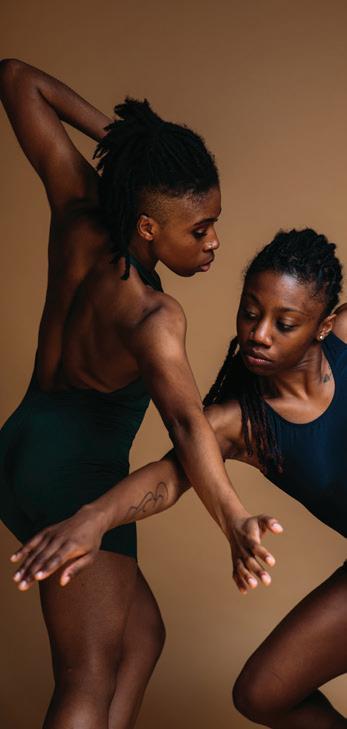
The title of Hyun Jung Jun’s exhibition reads like an incantation, as if upon entering the gallery, viewers will be instantly transformed. Fittingly, “by flame by fog,” Jun’s solo show at Goldfinch in East Garfield Park, conjures a glade, where reality is suspended and unearthly charms work a strange magic. Visitors enter through the back gallery and immediately encounter the building’s vine-adorned windows, kissed by several wax figurines shaped like winged insects. A burst of color hits if you turn around. Jun has painted two walls in broad strokes of reds and blues, creating the illusion of a windswept and misty landscape that dizzies the eye. On small wooden shelves perch more wax critters, their wings extended as if ready to flutter skyward.
Jun, an Evanston-based artist, makes artworks that are meant to be transient as much as they play with our stock measure of time. She has received national press for her elaborate, edible cakes, made under the name Dream Cake Test Kitchen, whose aesthetic one could describe as Seussian cottagecore. Look closely at her wax sculptures, and you’ll see that they are candles; the wicks of the Goldfinch batch seem to double as graceful antennae. Carefully dipped in Jun’s kitchen, each candle is intended to eventually meet
Through 7/ 17 at Goldfinch, 319 N. Albany, goldfinch-gallery.com


Bubbles and clouds in the a ernoon , archival inkjet prints mounted on walnut by Hyun Jung Jun

their fate by fire. “I actually want people to burn these, I want them to perish,” Jun said when we spoke in mid-June. “Really to just disappear.”
She first began working with candles as an undergraduate at the School of the Art Institute of Chicago when she would light them on fire in performative pieces. In Jun’s Candles & Water Gun (a 2012 work including a series of images and a performance), she squirted a water gun at a lit candle and photographed her attempts until she hit her mark. The resulting images of this markedly fatuous race between water and fire revel in the subtle shifts of a metamorphosis interrupted.
Ideas of shape-shifting and suspending time have continued to guide Jun, though her candles have since become less stick-like, more fantastical. Those at Goldfinch are inspired by moths, which break from their long sleep in cocoons spun by their former caterpillar selves.
Jun’s moths are fetching but undeniably grotesque, presenting nubby protrusions on their wings and abdomens and a color palette that blends earth tones with high-key hues that bring to mind a confectioner’s counter.
“The candles before this were butterflies, and I wanted to go into a direction that’s a little bit darker,” Jun said, noting that she is also afraid



of moths: “They’re really beautiful, but I’m not over their eeriness.”
There is something quietly unsettling about Jun’s wax creatures, displayed to recall pinned species in a nascent lepidoptera collection and destined to burn. Fully formed for now, but not quite in flight, they suggest in this moment our own positions as humans emerging from more than a year of limbo: profoundly changed, dizzied, and surviving precariously.
When life now seems surreally supercharged and repressurized as Chicago reopens, “by flame by fog” proffers a timely invitation for deep introspection. In addition to candles, Jun has assembled on one windowsill cracked eggshells that cradle strawberry seedlings; on one wall hangs small, photographic stills of the moon and clouds, taken from footage Jun recorded in Chicago and her native South Korea. Like the cleansing licks of fire or the nebulous drift of a rising brume, these simple scenes denote meditative ways of experiencing time, as a slow but persistent unfolding. Indulge in minutiae and dream against routine, Jun seems to urge, while asking: Who can we become when we stall the consuming march of time? v
@claire_voon
chicagotakes10.org

ART REVIEW







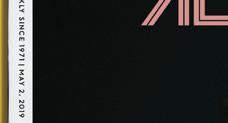





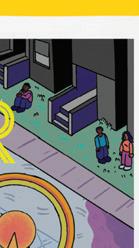




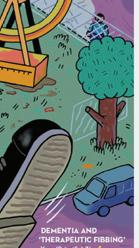
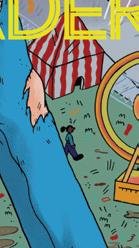 By DMITRY SAMAROV
By DMITRY SAMAROV
Does a comic strip belong on a museum wall? I ask this not to question the value of cartooning, but because I wonder whether a wall is the best place to experience what comics are designed to do. This ate at me as I wandered through “Chicago Comics: 1960s to Now,” the generous survey of 60 years of Chicago’s cartoonists currently on view at the Museum of Contemporary Art Chicago. There’s absolutely no question that much of the work on display deserves to be known and celebrated. But are the walls of a museum the right venue?
A comic strip is read as much as it’s seen. The artist/writer spends years honing their style and vision, experimenting with format and presentation, but most of the time, the ultimate destination for cartoons and comic strips is the printed page rather than a wall. Context is paramount to the audience’s experience in art, so when comics are taken out of a newspaper or book, something is inevitably lost.
There’s certainly no faulting Dan Nadel, the curator of the exhibition, for the sweep and breadth of this survey. The show traces the art form’s evolution from newspaper mainstay to alt-weekly counterculture outrageousness to hermetically personal expression. Any visitor with even the most casual interest in comics should be able to find something to fall in love with here—but something still didn’t quite connect for me, no matter the quality or subject matter in the vitrines or on the walls.
Nadel was obviously aware of the challenge of displaying art created to be held in one’s lap, up close, and experienced privately. The exhibition addresses this problem with supplementary materials. In the room devoted to Ivan Brunetti, there is a shelf of his personal collection of toys and figurines. Other rooms have maquettes and other work product meant to give context to the artists’ processes. Additionally, many walls are taken up by vinyl blowups of single panels or details of drawings. These oversize copies do little to illuminate each artist’s unique vision and contribute to a chaotically busy visual presentation. The exhibition experience at times felt like being at an estate sale: having to consciously ignore a lot of noise in favor of the isolated objects of personal interest.
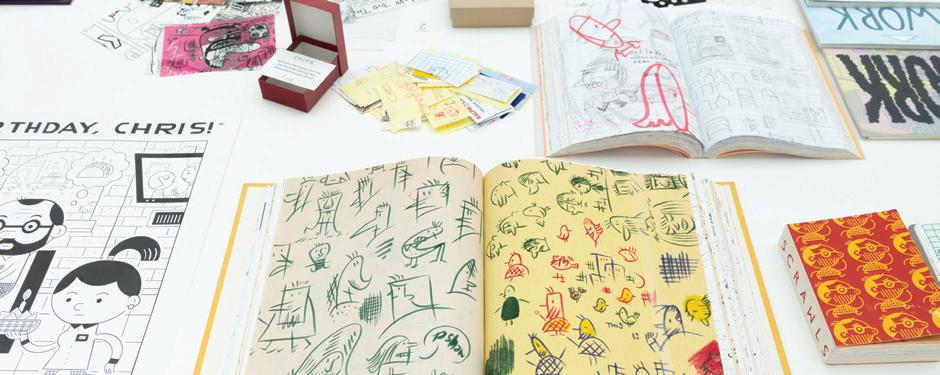
There’s such a polyphony of approaches and styles that it felt like artists were yelling over each other. Other times, there was a disconnect between my longtime experience of particular work and how it was presented in these rooms. Lynda Barry’s exuberant panels felt strangely muted, while Chris Ware’s obsessively ordered work su ered from a busy salon-style grab bag installation.
The highlights of the exhibition were younger artists whose work is not dependent on either narrative sequencing, nor the printed page. Edie Fake’s abstract architectural prints left a mysterious magnetic charge and Lilli Carré’s video loop of ever-mutating female figures from art history, seemingly made of



Through 1 0/3 at the Museum of Contemporary Art Chicago, 220 E. Chicago, mcachicago.org






































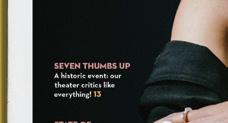



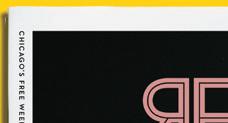



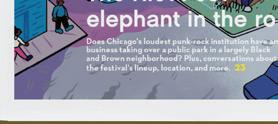






rubbery bubblegum, made me smile. I sat through the sequence four or five times and could easily have stayed longer. If I had to choose a favorite, it would be Jessica Campbell’s wall of weird acrylic carpet creatures. Their bright industrial colors and artificial turf texture were like a 21st-century update of Henri Matisse’s Jazz series. Unlike so much of the work presented here, which su ered by being ripped from its natural habitat, these funny figures absolutely owned their environment. I could stand anywhere in the gallery and they commanded attention in a way the small ink-and painted-pieces-on-paper of the others couldn’t.
This show is a love letter to comics and our city’s role in comics history. I’d never skip a chance to examine original art by longtime favorites and the inclusion of Black artists’ work going back to the 1940s is illuminating and necessary. For anyone interested in the nuts and bolts of the medium, there are countless examples of in-progress or partially completed drawings that will be especially valuable to young people looking to get into art themselves. In the absence of a more suitable venue than an art museum, I’d urge anyone interested in comics and in this city’s history and culture to visit. But afterwards, pick up Barry’s The Greatest of Marlys, Ware’s Jimmy Corrigan, and the exhibition’s accompanying reprint of It’s Life as I See It: Black Cartoonists in Chicago, 1940-1980 to experience the genuine article. v



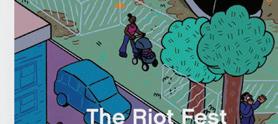
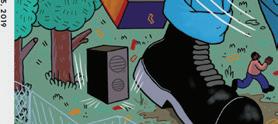
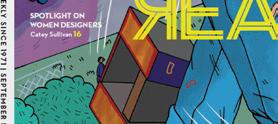

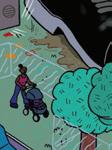

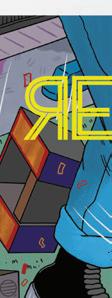




A survivors’ story fraught with intrigue, bravery, and human frailty
(SCENES FROM THE BRITISH WRECK COMMISSIONER’S INQUIRY, 1912)
BY OWEN MCCAFFERTY |DIRECTED BY VANESSA STALLING
STREAMING ON-DEMAND JUNE 14 - JULY 11, 2021
Tickets at (773) 753-4472 | CourtTheatre.org
Sponsored by Gustavo “Chip” Bamberger and Martha Van Haitsma, the Sidley Austin Foundation, Karen and Bob Lewis, Kevin Hochberg and James McDaniel, and the Elizabeth F. Cheney Foundation
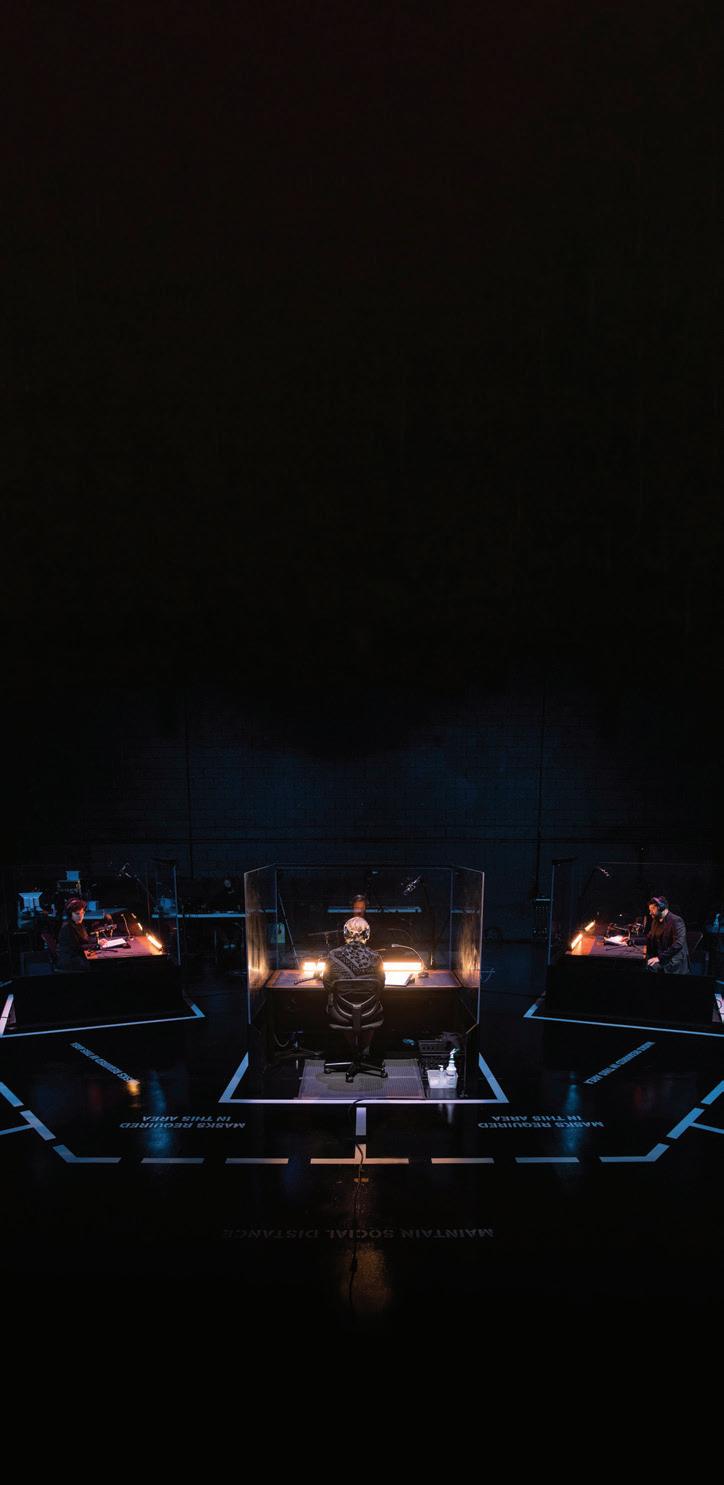

If the great surrealist painter Salvador Dalí and iconic LSD proponent Timothy Leary designed an after-hours club during the height of a pandemic in Cabaret-era Berlin, it would definitely look something like Eschaton (Virtually) wander the seductively murky, always tantalizing rooms of Eschaton’s gloriously bizarre, hour-long livestream and you’ll find dancing magicians, burlesque strippers, sultry chanteuses, giant rats, drag royalty, profane puppeteers, and Chicago’s Tony Grayson, coughing up cockroaches and trying to clean up a murder scene in the north side attic of an underground comedy venue.
Grayson’s your host, a poet/performance artist who sometimes wears a massive papier-mâché mask and sometimes speaks in extreme close-up, their face peering out from inside a mini set they created: a parlor-like room just big enough to accommodate an adult-sized human head.
“My brain at the beginning was like, OK,
we’re doing this stream show in place of the in-person show. But as we went on, it became obvious: This wasn’t a replacement. This was the show—in a new medium. With elements you can only create with digital, interactive film,” Grayson says.
Its title comes from the Greek for (roughly) the end of history, or the last event in some higher power’s divine plan. Eschaton didn’t start out as a virtual show, with audiences meandering via mouse clicks through the tantalizing shenanigans of a labyrinthine club where a weird new adventure lies within each of a dozen or so Zoom rooms.
Creators Brittany Blum and Tessa Shea Whitehead originally planned an immersive, site-specific interactive production along the lines of Sleep No More , where ticketholders wander through di erent rooms as a multilayered, never-the-same-twice story unfolds.
“We started out the pandemic thinking that we needed to find an alternative, some way of
doing an immersive show without the beingthere-in-person physical immersion,” Grayson says. “But as we worked, we started to realize that what we were creating wasn’t a substitute for anything—virtual Eschaton became its own thing,” they say.
Indeed, Eschaton is very much its singular own thing. Audience members are free to loiter in the various Eschaton rooms as the spirit moves them, piecing together the many narratives woven into the production’s uncompromising, celebratory freakiness.
Throughout, Grayson plays Niko, a genial if comically insecure host-with-the-most, gifted at using their considerable offbeat charms to draw out even those who habitually take a hard pass when it’s time for “audience interaction.”
“As an audience member, I’m somebody who finds it nerve-wracking when someone in the show calls on you. So it’s important to me that our audience knows they are in good hands. You can’t be just like ‘Where are you from? OK, cool,’ and then it’s like all the air gets sucked out of the room because nobody knows what to say next.
“With Eschaton, I work to make sure there’s never that hesitancy when I’m doing crowd work. If an audience member doesn’t know what to say, that’s OK, because my job is to navigate that with the classic rule of improv— make your scene partner look as good as possible,” they say.
Grayson has had some mondo-bizarro scene partners wandering the halls of Eschaton , where audiences are asked to keep their cameras on throughout the 60-minute show.
“The craziest thing I ever saw was this guy Kevin, who had magnets implanted into his fingers,” Grayson says. “Sometimes that happens—I’ll be chatting with people throughout the show and suddenly I’ll stumble onto something incredibly odd and I’ll be like, ‘What even was that?’
“We had one regular couple for a while who brought this creepy doll they’d make talk. Loved it,” they say.
Along with Blum and Whitehead, Grayson was joined in devising the piece with ensemble members in London, Berlin, New York City, and Tennessee. Audience members have visited Eschaton from as far away as Tokyo.
As the pandemic raged, Grayson found solace in dancing with total strangers miles away.
“I do a bit where I ask someone to dance. I can’t really explain it—but dancing with people virtually? It makes you feel better. It makes you create a community in a pretty amazing way,” they say.
Niko—who Grayson conjures as equal parts raging insecurity and over-the-top showboat—lives in the attic of Chicago’s illustrious DIY performance venue The Shithole, where Grayson lives on the first floor. On show dates, Grayson trudges up to the attic with their kit of lights and audio equipment. In non-pandemic times, rowdy, sweaty crowds pack the place for late-night o erings of performance art and stand-up. For now, the attic is solely Niko’s turf.
“Going back up there for Eschaton , it was like walking into a ghost town,” Grayson says of the attic space. “But the energy of the people that had been there, you could feel them. The old beer cans. The sweat. All this amazing energy, palpable.”
Finding that energy was crucial to Grayson’s artistic survival over the long lockdown. After Eschaton ’s first show, they packed up their laptop, cameras, and sound system and descended from the attic back to the living quarters.
“My roommate hugged me and asked how it went,” Grayson recalls. “And all I could think was that it felt like art really mattered. I go through these phases—especially in the pandemic—where I’m always asking myself: ‘What are we even doing? Who is this even for?’ But I exited the attic that night knowing how much art means to people. And always will mean to people.”
Grayson also found themself connecting with the ensemble, even though they never met in person.
“We do these aftershow hangs, and there was one when we all realized we were using the same Neutrogena wipes to clean off our makeup. It was such an unexpected, weirdly specific connection. We all felt, all of a sudden, like we were about to go out after the show,” they say.
Grayson’s optimistic live Shithole shows will return. But for now, they invite all and sundry to Eschaton. It’s worth the trip. v
Next dates for Eschaton are TBA. See info.eschaton.club for updated info.
@CateySullivan











































Chicago Tap Theatre and JC Brooks team up for a new live show with a 90s beat.
By MELISSA PERRYAfter nearly a year and a half of Zoom dance class and virtual performances, Chicago Tap Theatre is trading in clap emojis for applause from a live audience in a return to the big stage with their new production, Tap Secret!, which will be performed in two shows at North Shore Center for the Performing Arts on July 10.
“We kind of felt like it’s been a tough enough couple of years for all of us, and what everybody deserves right now is cotton candy,” says Mark Yonally, CTT’s artistic director and choreographer of Tap Secret!. “There certainly is some subtext to this show, but taken on a surface level it’s just a joyful, funny kind of show.”
To maintain social distancing, only 350 tickets from this 1,000-seat theatre will be
available for purchase per show. While Tap Secret! will not be livestreamed, the company is planning to film a high-quality rendition of the show that will be released at a later date.
Founded by Yonally in 2002, Chicago Tap Theatre has set itself apart from other dance companies through its story shows: a play with an original story line conveyed through tap dance.
“We have done story shows that were kind of heavy before. We’ve done ones that were dealing with really tough subjects,” Yonally says. “We made a very conscious effort that this is not that.”
While a play that replaces dialogue with tap dance may seem unconventional, CTT dancer and rehearsal director Sterling Harris views
tap dance as a very clear form of storytelling.
“Tap has a very innate ability for communication. When I’m watching tap, I can really tell what someone’s emotional consciousness is behind a certain step,” Harris says. “Even though we don’t have words, the rhythm of our feet can do a pretty good job of taking over.”
While tap dance is used as the primary storytelling medium in Tap Secret!, audiences can also look forward to a one-of-a-kind story line and original score from beloved Chicago artist and CTT’s music director, JC Brooks.
Many fans know Brooks as the lead singer in JC Brooks and the Uptown Sound, a soul and funk band that tours across the U.S. and internationally. But alongside his work with his band, Brooks carries a robust love for musical theater and performance.
“Theater’s been a constant thread through my life, even with the band,” Brooks says. “As far as trying to score a piece, I never imagined doing that 20 years ago when I was getting a degree. So that’s a little bit of a departure, but it’s also something that at this point feels inevitable because of my love for music and musical theater specifically.”
The director of Tap Secret! , Mike Weaver, also comes from a unique musical background. In addition to holding degrees in filmmaking and piano jazz performance, he is one of the most well-known show choir choreographers in the country and the coauthor (with Colleen Hart) of the book Sweat, Tears, and Jazz Hands: The Official History of Show Choir from Vaudeville to Glee.
Collectively, these artists hope to craft an original yet vibrant viewing experience for their live audience. From the very beginning, their creative process has relied upon collaboration as they bring together elements of tap dance, music, and storytelling.
“We took JC’s plot, and Mike turned it into a script. Then, I worked with Mike to play with some of the story details to make everything work and to play to some of the strengths of tap dancing to tell the story,” Yonally says.
Tap Secret!, which is set in the 90s, follows Paulie (played by Harris), a sound engineer who embarks on a journey to save the music industry with his love for rhythm. Paulie starts to become alarmed by the rise of over-man-

ufactured pop music that is overshadowing “the beauty and intricacy of music rooted in polyrhythm,” Yonally says.
“He works in a lab where they’re testing out some new technology, but he sees that it is actually hypnotizing people and is conflicted about it and wants to do something,” Brooks explains. “He gets recruited by a group of rhythm spies to help defeat this new evil plot to enslave the world through pop music.”
Even more, the music conglomerate that Paulie works for is called “EmptyV.” Sound familiar?
From the very beginning, Brooks knew he wanted to set the storyline in an easily identifiable time period. Ultimately, he landed on the 90s due to his own personal connection to that era.
“That was when I came of age, so it’s just the music that I gravitate towards,” he says. “I saw this clip of this MTV interview where David Bowie is asking why MTV doesn’t really play Black artists and that was the motivation for this war that was playing out in the original draft of the script.”
As he crafted the score for Tap Secret! , Brooks drew from familiar pop sounds from the 90s in addition to more intricate rhythms such as jazz and Afrobeat.
“I was trying to draw the dichotomy between this Max Martin style of overproduced pop and the polyrhythmic world,” Brooks says.
Along with Brooks’s compelling score and story line, audiences can look forward to enthralling choreography from Yonally and his dancers. Recently, some younger, fresh faces have joined the company’s ranks, but unfortunately the pandemic has limited their performance opportunities. Now, they can finally share their passion for tap dance with a live audience.
“We got some pretty heavy-hitting talent right now,” Yonally says. “So I think people are really going to enjoy the level and sophistication of the artistry and technical prowess that these dancers are capable of.”
In Tap Secret! , CTT’s company members aren’t just dancers, but musicians and storytellers. This unique expression of artistry is something that audiences should look forward to, Harris says.
“I think the show is very exciting. It’s a way to experience a story line that may be unique to you, and familiar at the same time,” Harris says. “It’s full of energy and it’s full of joy and it’s full of tap dance.”

Forget plaques and tchotchkes—the Berlin Wall has got to be the ultimate diplomatic souvenir, as slabs of the enormous, concrete barrier have made their way to spots around the world. More than 40 are on display in the United States, both privately and publicly; there’s even one here in Chicago at the Western Brown Line station. A tour of these spots comprises this deceptively high-concept documentary by nonfiction filmmaker Pacho Velez (Manakamana, The Reagan Show) and experimental filmmaker Courtney Stephens. They travel the United States in pursuit of locales where sections of the wall reside, more than 20 years a er its eradication in 1989. Velez and Stephens do more than show the fragments; at various spots, they interview people they encounter about the experience of seeing, living near, or having acquired a piece of the iniquitous barrier, the speakers ranging from nameless (and sometimes even faceless) tourists to art collectors and administrators at civic and historical locations. Ultimately (and fittingly) the documentary illuminates not the history of the wall or how so many fragments of it came to the U.S., though that’s naturally a factor here. (Some home video and archival footage add gravitas, imbuing the aporetic inflection of the project’s aim with an appropriate reverence for the struggles faced by the east Germans.) Rather, it’s the myriad interpretations of the wall’s significance that exposes the mercurial and allegorical nature of history. This is complemented by the stirring 16mm photography and the studied distance with which Velez and Stephens interrogate the past. —KATHLEEN SACH s 69 min. Music Box Theatre
Down A Dark Stairwell aims to humanize a polarizing incident by offering an intimate and gripping account of Akai Gurley’s life and untimely death. In the fall of 2014, Peter Liang, a Chinese-American police officer, shot and killed Gurley, an innocent and unarmed
Black man, in a dark stairwell of a Brooklyn apartment building. A celebration of Gurley’s life anchors the film as it ventures out to explore the complex ways both men suffered at the hands of an unjust criminal justice system. While the film does a good job providing key details about Gurley’s and Liang’s lives leading up to their intersection, it’s the examination of the a ermath, in which two marginalized communities react to the tragedy, that provides the most commanding commentary on the racism embedded in law enforcement agencies. Relevant, if at times reserved in its condemnation of Liang’s actions, Down A Dark Stairwell is worth watching. —BECCA JAMES 83 min. Gene Siskel Film Center From Your Sofa
The Forever Purge is as diluted as one might expect of a franchise’s fi h and final installment. The title, of course, tips viewers off to the twist, which is that instead of the annual 12-hour event in which all crime is temporarily legal, this time, a group of people have decided the annual Purge should go on forever. Blunt and at times a bit boring, the film follows Adela (Ana de la Reguera) and her husband Juan (Tenoch Huerta), who live in Texas, where Juan works as a ranch hand for the affluent Tucker family. Eventually, the two families must band together to save themselves from a “diseased” America. While this may seem like the perfect setup for a nuanced social commentary on class divides, which some of the other films pull off to a varying degree, it, unfortunately, devolves into a collection of manageable metaphors and tepid takes. —BECCA JAMES 103 min. In wide release in theaters
Good on Paper is a smart and sweet take on modern love and manipulative lies. The movie catches up with stand-up comedian Andrea Singer (Iliza Shlesinger) a er years of putting her career first begins to take a back seat to the possibility of romance. Enter Dennis (Ryan Hansen), a guy who is smart, nice, success-
ful, and, as Andrea’s friend Margot (Margaret Cho) is eventually convinced, possibly too good to be true. The result is a wild goose chase that sees the besties desperately searching for Dennis’s faults. Shlesinger’s semi-autobiographical tale picks up where her Netflix stand-up specials and supporting roles le off, placing her at the center of a movie where she employs the same sharp humor as the latter and subtle humanity as the former. Even though a few weak spots sneak through the wit, Good on Paper far exceeds its self-deprecating title, offering more than most in the romcom genre. —BECCA JAMES 92 min. Netflix
Summer of Soul (. . . Or When the Revolution Could Not be Televised) could command attention just by virtue of its treasure trove of previously unreleased vintage footage of R&B, soul, gospel, jazz, and blues legends, including Nina Simone, Stevie Wonder, Max Roach, and Sly and the Family Stone. But the documentary, which spotlights the 1969 Harlem Culture Festival, a six-week series of free performances celebrating Black music and culture in Harlem’s Mount Morris Park (now Marcus Garvey Park), is much more than a standard concert film. In his directorial debut, multi-instrumentalist, DJ, and Roots drummer Ahmir “Questlove” Thompson tells the story of the festival through the eyes of its producers, artists, and attendees. A straightforward compilation of performance clips would be riveting in its own right, but in Questlove’s hands, the concerts become a porthole into broader discussions of Black history, community, and identity in the mid- to late 60s—a turbulent period beset by civil unrest, ongoing war, and political assassinations. Presented against the backdrop of these iconic performances, Summer of Soul seems to suggest, come for the music, stay for the revolution. —JAMIE LUDWIG 117 min. Hulu and wide release in theaters
The Tomorrow War is the cathartic summer action film we all need post-pandemic and wastes no time getting right to the story. We’re losing a war with aliens 30 years in the future, so time travelers have come back to dra us to save the planet from an extinction event that is kind of our fault. No surprise, all the pivotal characters have just the skills they need to save the world. Dan Forester (Chris Pratt) is a high school biology teacher and Iraq war veteran who wants to do more with his life. He’s got daddy issues with his badass, tech-savvy, airplane-fixing father James (J.K. Simmons), also a veteran. You bet that plane will come in handy. He also has raised a daughter who is a lot like him in good ways (scientist) and bad (daddy issues). But it doesn’t matter because this movie is a blast as long as you turn off your brain, ignore the enormous plot holes and hokey time-travel explanations about why they can’t just
Get showtimes and see reviews of everything playing this week at chicagoreader.com/movies
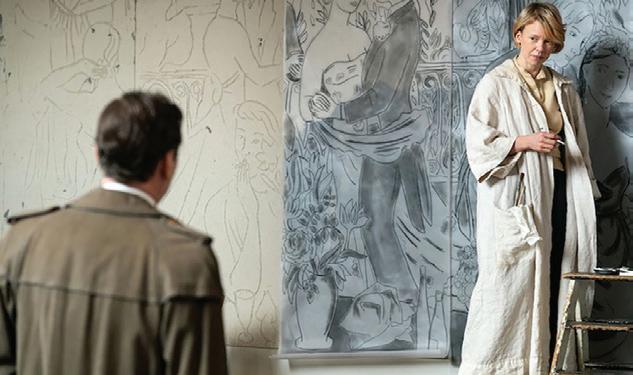
go back before the aliens came but can only return to this one spot, and accept that they will keep all the vital information at bay until the plot or characters necessitate it. Like most action film stars, Pratt’s character makes mostly bad decisions, placing the needs of saving one person over the survival of the species. But the film does a great job of just being fun and using time travel to tell a story about the generational regrets we hold on to in our families. And, unlike most action films, it has a satisfying and not-drawn-out climax. —JOSH FLANDERS 140 min. Prime Video
Tove attempts to illustrate Swedish-speaking Finnish artist Tove Jansson, creator of the Moomins, a fantasy series that features eccentric and distinctly shaped characters, which inspired a cult following. The thing is, little time is devoted to detailing her artistic pursuits as a young painter struggling to find success during the tail end of World War II in Helsinki. Instead, the film follows Jansson’s (Alma Pöysti) romantic relationships as they progress over a decade. The two long-term affairs, one with affluent theater director Vivica Bandler (Krista Kosonen) and one with le ist philosopher Atos Wirtanen (Shanti Roney), provide the biopic with a so sense of drama as Jansson goes back and forth between the more reliable Wirtanen and the ever-elusive Bandler. While this does a disservice to Jansson’s legacy, mostly brushing aside her memorable body of work in favor of her romances, it still makes for a beautiful portrait of desire and despair. —BECCA JAMES 116 min. Music Box Direct
Originally debuting at Sundance in 2020, the theatrical release delayed due to COVID-19, the film Zola is heavily inspired by a legendary series of 148 tweets by A’Ziah “Zola” King who recounts a wild strippers weekend with a new friend that quickly goes sideways. Themes of power, ownership, and blurry consent play out both onscreen and off, in the rush by the press and Hollywood to commodify King’s story, which was passed through several hands including James Franco’s, before ultimately landing with director Janicza Bravo and writer Jeremy O. Harris to create the film. While Bravo and Harris could have chosen to sit heavily in the weight of this cautionary tale, this de ly written roadtrip story is held up by a scaffolding of excitement and mirth, channeling the zest of being young, hot, and out of fucks to give. Ultimately, Zola is the perfect summer film; it’s a freewheeling joyride through the seamy side of stripping that balances the thrill of voyeurism with the dangerous reality that beautiful women who entertain face with a wink and a smile. —SHERI FLANDERS 90 min. in wide release in theaters including AMC Theatres, Logan Theatre, Regal Theatres, and Showplace ICON v














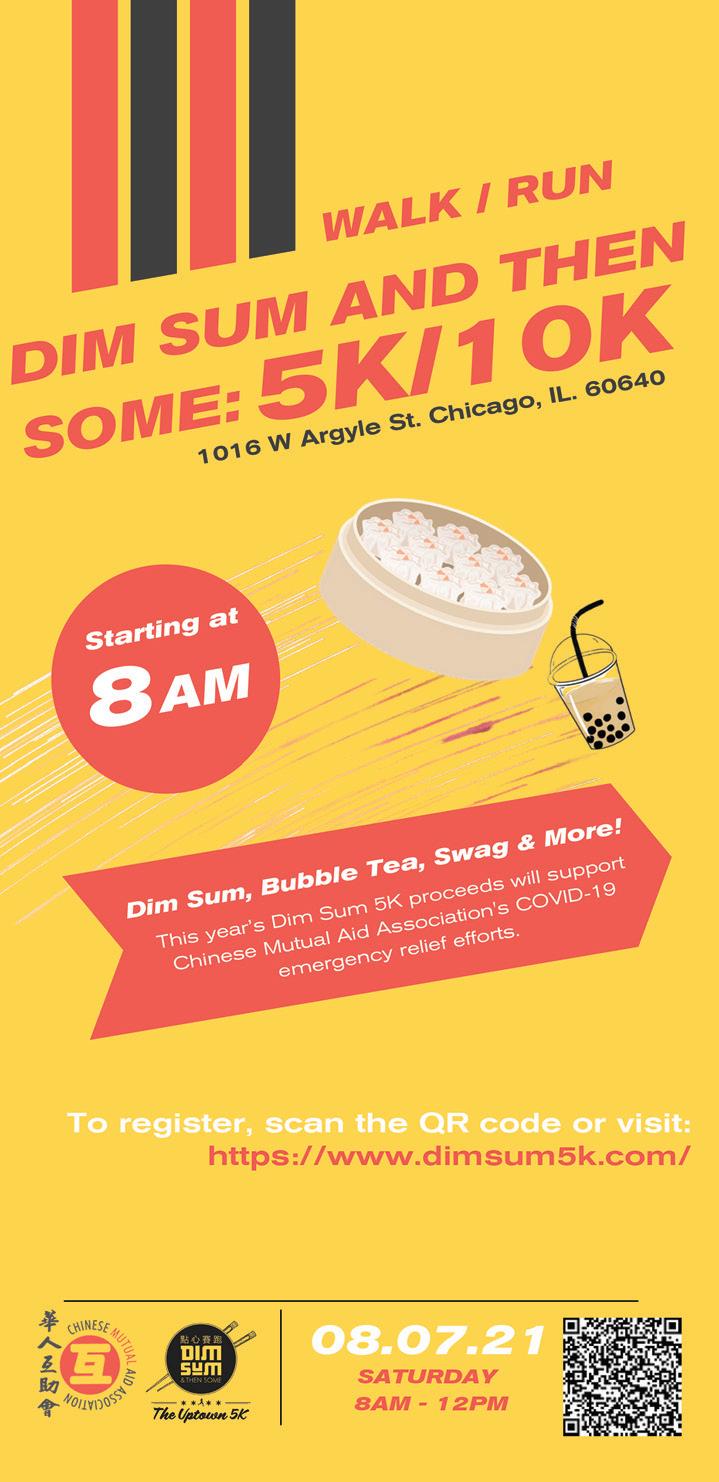
Azeez Alaka and Brandon Holmes run a music and video production company with a pipeline to the majors and a headquarters shaping up in Little Village.
By JACK RIEDYAzeez “Laka” Alaka and Brandon Holmes have a clear vision for their production company, No More Heroes, even if their headquarters is still under construction. In November 2020 the friends and business partners bought a vacant commercial building on 19th near Douglass Park, and on an overcast May afternoon they lead a tour of it, explaining over the sound of power tools how everything will eventually be laid out. They point out the eventual locations of recording studios, common spaces, a grassy backyard for cookouts, and sets being built to resemble jails, hospitals, and courtrooms—which, they joke, will get you far in the world of rap videos.
The founders of No More Heroes searched for three years to find a spot that could accommodate the late hours, loud noises, and various forms of smoking that often go handin-hand with recording studios. Alaka and Holmes had competed for the building on 19th with nearby film and television studio Cinespace, but they closed the sale—the first step in creating a home base suited to their rising prominence in hip-hop. “It’s gonna be a place where people gon’ come, even if they don’t wanna record here,” Alaka says. “They might just wanna bump into us.”
Alaka and Holmes began working together in 2018, when the former was still operating as Laka Films, and o cially adopted the name No More Heroes in April 2020. During those three years they’ve created videos for some of the biggest names in major-label rap, including Lil Durk, G Herbo, and Polo G, as well as upcoming

talents such as Pronto Spazzout, Lil Eazzyy, and DCG Brothers. Their work is full of striking moments that feel engineered to resonate as looping excerpts on social media.
In the video for DCG’s “Mmhmm,” the rappers lip-synch while messing around on a golf course—dancing, humping the ground, flipping golf carts. Its playful, memorable contrasts—between the bourgeois setting and their goofball antics, and between the silly tone of the video and DCG’s street-rap lyrics about selling drugs and scaring rivals—earned accolades from Pitchfork and Stereogum (as well as from the Reader). “Everyone think all these hood artists aren’t that creative, but they are—you just gotta put them in that environment,” Alaka says. “And if you make them think it’s cool, you’re just building a bigger fan base.”
Connor Wiles of Chicago video-directing duo New Trash calls Alaka a legend. “Any version of the city’s rap history without him is incomplete,” he says via Instagram message. “Even with the amount of videos [No More Heroes] do, they still always have these super unique visuals and somehow never repeat themselves, which is like the hardest thing to do. I’m always looking forward to what they’re gonna drop next.”
Holmes and Alaka’s for-hire video business is thriving already, and they have plans to expand in several directions. Their YouTube channel features an in-studio performance series called Red Light Freestyles, which has posted four installments since it debuted with a G Herbo verse in April 2020. They’re also active in artist development—most notably, they worked with DCG to grow their following and in the process helped land the group an Atlantic Records deal. And No More Heroes have taken an active role in creating some of the music that comes out of their shop, earning credits (and thus royalties) when Holmes and Alaka choose beats, hire rappers for verses, or o er other artistic input. Despite their work with major labels, they’ve maintained their independence—which leaves them free to take any job they want. “Why can’t we have a poppin’ YouTube and still go shoot $100K, $200K videos for labels? We just try stu . Shit, we bought a building,” Alaka says, laughing.
No More Heroes’ closest cousin in Chicago is Lyrical Lemonade, an operation that began as a hip-hop blog in 2013 and has since evolved to include artist management, event production (most notably for the Summer Smash festival), a clothing line, and music videos directed by founder Cole Bennett. The main difference so far is that Alaka and Holmes also act as producers à la DJ Khaled. Alaka grew up on the south side and began
his career in 2014, when he launched the Laka Films YouTube channel. His personal social-media handles still bear that name. “I just dropped out of school, pretended to be younger, went to YouMedia, learned a couple skills on YouTube, then went to the streets of Chicago and clicked ‘record.’ And figured it out!” he says. Alaka filmed bop and drill artists at a time of renewed national interest in Chicago’s rap scene, earning millions of views and a sizable following. “I was getting YouTube checks, feeling like the man,” he recalls with a grin. Alaka later met a director who goes by Daps, who taught him how to write industrystandard treatments and expand from his early single-camera shoots to more elaborate productions.
Holmes grew up in southwest-suburban Yorkville and started shooting videos in 2015 using a friend’s grandmother’s camera. After making more than $200 in a week, he quit his day job. “We just hustled,” he says. “Moved to Chicago, ordered a bunch of camera gear on credit cards and Amazon accounts, paid it o , kept going, and made it to where we are now.” He launched his own YouTube channel in 2016, and though he gradually abandoned it as his partnership with Alaka took o , it’s still hosting the videos he made a few years back for hot locals such as Taco and CupcakKe.
Viral successes such as DGainz’s 2012 video for Chief Keef’s “I Don’t Like” had become essential to turning independent street rappers into stars, and both No More Heroes directors learned that lesson from seeing it happen. “That’s what makes us the rawest A&Rs—we watch music videos from upcoming cameramen,” Alaka says. “No one has ever got on in our city without shooting a video with an upcoming cameraman. It’s impossible.” Because they leapt into the music industry DIY style, without wasting time with gatekeeping institutions, they’ve amassed far more experience in the biz than you might expect of two 26-year-olds—just like many of the independent rappers they’ve worked with.
Alaka and Holmes were introduced by a mutual Tinder match in late 2017 and met in person while working on the set of a TrenchMobb video. Alaka first hired Holmes as a camera operator in 2018, and they soon became friends and trusted collaborators who speak every day, though they’re not often in the same city at the same time.
In person, the two men couldn’t come across more different. Holmes’s voice rarely rises above a calm murmur, while Alaka’s speech picks up speed and volume rapidly as he dishes about the industry. He dismisses amateur rappers who want to “make it” without putting in the work to consistently release music, and he’s just as scornful of major-label artists
who go into debt to their labels or waste their advances on lean and other indulgences.
Their disparate personalities give them more tools to manage dozens of people on a marathon video shoot, which they typically finish in one 14- to 18-hour day. And their growing reputation is attracting a range of artists, even those who might be rivals musically or otherwise. “I just don’t get involved in personal matters,” Alaka says. “If I don’t come there gangsta, I’m not shaking up any gang signs, I’m not trying to be what I’m not, people just respect it.”
“We just stay out the way and give everybody a chance to tell their story, creatively,” Holmes adds.
Alaka and Holmes began thinking about rebranding in late 2019, after noticing waning interest in the Laka Films channel. They spent four months considering new names for the enterprise. “Laka Films” put all the emphasis on Alaka as an individual, and he wasn’t comfortable with that anymore—one of his biggest regrets is trying to be too independent when he was just starting out. “Black people in general have trust issues, and trying to do everything by themselves,” he says. His partnership with Holmes changed all that. “As soon as we teamed up, G, everything went times three, times four, times five.”
The new name came to the team right at the beginning of the pandemic lockdowns. “The first day, we had our meeting, we went to go grab our whiteboard, and we made our name,” Alaka says. “All we had to do was sit down!” COVID-19 gave them an opportunity to slow down and consider their next steps, though they continued traveling to film, albeit sparingly (and with slimmed-down crews following COVID protocols). This let them take advantage of the fact that so many people were stuck inside with plenty of time to watch videos.
Holmes and Alaka settled on “No More Heroes” because of what they’d experienced traveling with Chicago singer-rapper Juice WRLD on his last tour before his death in 2019. Each night they saw more than 200 people working together to put on the show, and the two of them wanted to emphasize a similar spirit of teamwork in their own company. “We are the furthest thing from a one-man show,” Holmes says. They commissioned a logo from Los Angeles-based illustrator Jake Larsen that taps into the superhero-saturated zeitgeist, combining elements of Spider-Man’s mask, a comic-book word balloon, and the universal “no” symbol. The first Red Light Freestyle— the G Herbo episode on April 20, 2020—was also the debut of the new brand.
Chris Zielinski, a content director and longtime friend of Alaka’s who’s been working with
him since 2016, explains one of the benefits of the change. “Laka Films, I’ll wear a T-shirt because that’s one of my best friends. But no one else is really gonna wanna rock a Laka Films shirt, because they don’t necessarily want to be underneath you,” he says. “But if you have a brand that makes you feel like a part of something—‘No More Heroes’ sounds cool and sounds like something I could get behind.” That said, the production company still maintains something of a hierarchy, even though Holmes and Alaka enjoy developing talent behind the camera and are quick to credit their collaborators. They each have a flashy chain with an iced-out No More Heroes logo—and only those two exist.
Even before No More Heroes embarked on their ongoing rebranding and expansion, they’d begun developing a relationship with DCG. The west-side rap group, consisting of teen brothers Bsavv and Shun, had reached out to Alaka to film a video for their 2019 track “Dangerous,” encouraged by his work with King Von, Famous Dex, and G Herbo. Bsavv remembers thinking, “I need Laka, he’s one of the most turnt persons in our city.”
No More Heroes were impressed with the young performers’ charisma, even in unscripted settings. Zielinski set up a tripod for an impromptu interview with DCG. “They were just talking and making jokes with each other, and Laka and I were looking at each other, knowing these kids have the greatest chemistry,” he says.
No More Heroes soon struck a deal to overhaul DCG’s image for a wider audience. Their changes included eliminating guns from ensuing videos and turning “DCG” from an inside reference into an aspirational backronym—it now stands for “Dreams Conquer Goals.” The group also moved to Los Angeles last year at No More Heroes’ suggestion, to better focus on music full-time. The changes are an interesting example of what’s acceptable in the larger music industry, even in street rap, decades into the subgenre’s existence. DCG’s songs still talk about drugs and violence, but in the right tone and with the right euphemisms to take o beyond Chicago. “Talk that gangster shit, but don’t name names, don’t be smoking your opps, stu like that,” Alaka says.
The group’s plans (and No More Heroes’ plans for the group) were complicated in early 2020, when Shun was incarcerated on gun charges, but he was released in May after three months. DCG had already worked with Laka Films, and they put out their first collaboration with No More Heroes in June—the video for the remix of “Okay” dropped just a few weeks after Shun returned home. The song, with a feature from fellow Chicago duo
continued from 31
Heavy Steppers, “helped take DCG out of the basement,” Zielinski says.
DCG say that the greatest thing they gained from No More Heroes was an understanding of their own potential to use hip-hop as a ticket out of bad circumstances, like countless rappers before them. “He got our heads on the right track and opened our eyes to life, to see how young we is and how much success we’ve got ahead of us,” Shun says. As they modified their image, the most important advice they received from Alaka and Holmes was to be themselves. “If you really know where you come from and what your past is like, you’re gon’ bring all that to your business,” Bsavv says.
Alaka had gone through this development process before with Chicago artist Famous Dex, and Dex’s videos are still some of the most viewed on the NMH YouTube page. But in 2016, when the rapper signed with Rich the Kid’s Atlantic imprint, Rich Forever, Alaka got no share of the deal. “You live and you learn—you mess up once,” Zielinski says. “The next time, before you go through the process of building an artist with you, talk to them and see if they want to have a partnership on it. You’re both contributing to the bigger image.”
Those lessons paid o for No More Heroes when DCG signed to Atlantic—the deal, announced in early June, was something of a joint venture, establishing a channel by which No More Heroes could bring more artists to Atlantic without tying them exclusively to the label. DCG commemorated the announcement with the release of “House Party,” a new song produced by buzzy collective Internet Money with a video from Cole Bennett of Lyrical Lem-
onade. Speaking by phone a few weeks after the announcement, Alaka and Holmes explain that they expect their connections at Atlantic to lead to more directing gigs for the label’s artists: “Being at the forefront of their minds, they’re willing to reach out to us first to o er projects that are reasonably in their realm,” Holmes says.
Holmes and Alaka want to keep developing No More Heroes as a musical entity, curating beats and pairing them with vocalists—that way they’ll earn a share of their work’s revenue in perpetuity, rather than receiving only a flat fee as is typical for a video. “Buying a song is real estate,” Alaka says. “You get points, you get money.”
The first musical release to credit No More Heroes was a February collaboration between DCG and Chicago rapper Lil Zay Osama, and when we spoke in May, Holmes and Alaka were already months into work on a collab with G Herbo and rising Memphis star Pooh Shiesty. The pairing’s appeal is simple: “Herb is a great artist on features, Shiesty makes some good hooks: you put it together and you make magic,” Alaka says. They created the song in several studio sessions, doing “surgery” on one long freestyled performance from Shiesty to create verses and hooks, then adding Herbo’s contribution. (“Freestyles don’t go viral,” Alaka explains.) Hype for the two rappers’ first collaboration built among fans as the track was leaked and teased across social media.
With the song complete, No More Heroes filmed a video for it with Herbo and Shiesty. The rappers’ labels haven’t released it yet, but Alaka is happy to describe it. “The ‘Switch It Up’ video is raw,” he says. “It is stupid. Shiesty
Brandon Holmes and Azeez Alaka outside the building they bought last November to house No More Heroes
TARIYAWN KNIGHTEN FOR CHICAGO READERNo More Heroes want to be a dominant force not just in Chicago rap but in rap, period. “We want to be like the next QC in Chicago,” Alaka says, referring to Atlanta label Quality Control Music, whose roster includes stars Migos, Lil Baby, and City Girls. “Just imagine if one person had Durk, Herb, Polo, and Juice all at once.” And though each project could take years to come to fruition, they have toyed with the idea of launching a comic-book series, a festival, or even a school.

switching into so many different things— we’ve got Shiesty and Herb switching they chains while they rapping, Herb jumping out a window skydiving, holding the Thor thunder. It’s stu you ain’t seen in a video! I don’t think people ready for it.”
But when the song “Switch It Up” was ocially released in late May, as the first track on the deluxe edition of Shiesty Season, it used a di erent beat—the rappers and their labels had been unable to clear the original. “The producer had a loop that was a sample, and we couldn’t find the sample, and they looked for weeks and tried their hardest, and that project had to drop,” Alaka says. Some fans who’d been excited by the leak were disappointed by the final version, with a few even sending harassment and death threats to No More Heroes.
Disgruntled cranks notwithstanding, “Switch It Up” has been streamed millions of times on Spotify alone, and No More Heroes hope the video will reignite the hype around the song when the labels decide to release it. “So much time was spent on it, and we were looking forward to it doing so much for us, and shit just did not happen,” Holmes says.
The delays and disappointments surrounding the “Switch It Up” video release haven’t slowed down No More Heroes’ plans or dimmed the founders’ enthusiasm. They’re at work on a full-length No More Heroes project, and DCG (who are also recording their own album debut) have already contributed verses. The company has also begun to push its second artist, Chicago rap-crooner FlyNari, with the release of “ChromeHearted” in mid-May.
“It’s real easy once you do it once,” Zielinski says. “You build the connections to take the next artist through the process.”
As an independent Black-owned start-up, No More Heroes also want to nurture the communities the company’s founders come from. They run internship programs where local high school students interested in the music business can earn class credits by shadowing NMH folks on their jobs, learning how to operate cameras, and receiving lessons in editing, networking, and building a portfolio. After protests and riots last June led to widespread property damage on the south and west sides, No More Heroes partnered with the Bronzeville Chamber of Commerce and Project Forward to organize a community clean-up day near 47th and King Drive. Holmes estimates 100 people showed up to clean (they were fed for free by local food vendors), and a simultaneous GoFundMe raised around $17,000 that the team distributed to 17 di erent businesses.
“We try to put as many people on as possible, as many Black people on as possible, and try to do so much for our community,” Alaka says.
“Chicago violence is just so bad, it’s hard to tell people to stay,” he admits. “But I think Atlanta violence is bad too, and somehow they figure it out.” He points out that hip-hop’s current capital city has a robust infrastructure of songwriters and studios, and says that he and Holmes hope their new headquarters will contribute to the growth of something similar in Chicago. “People come here, and they’re gonna record, and you’re gonna have all these so-called killers in sessions all night long,” Alaka says.
Holmes and Alaka emphasize that for all their lofty ambitions, they’re still building a business from a blueprint they’re drawing and redrawing as they go, trying to stay ahead of the ever-shifting music industry. Not every No More Heroes project has been a success, but they’re proud of what they’ve achieved so far. “Everything is growth. You always get excited when you do something, I don’t care what nobody say,” Alaka says. “Even if it flops! Even if no one comes to the studio, we put that shit there! I will rap!”
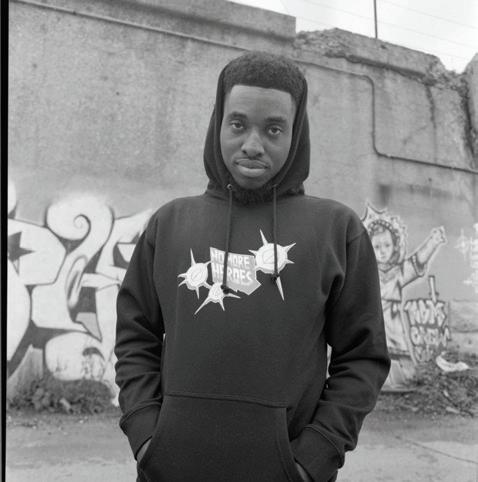
1035 N WESTERN AVE CHICAGO IL







773.276.3600

WWW.EMPTYBOTTLE.COM







8/14: ELIZABETH MOEN, 8/19 - 8/20: CLOUD NOTHINGS, 8/27 - 8/29: BULLY, 9/4: SCORCHED TUNDRA PRESENTS IN THE COMPANY OF SERPENTS, 9/14 - 9/15: THURSTON MOORE, 9/16: TORRES, 9/17:




NOUVELLE VAGUE, 9/18: ALGIERS, 9/19: COMBO CHIMBITA, 10/2: FAT TONY + CADENCE WEAPON, 10/3: NATION OF LANGUAGE, 10/7: WILD PINK, 10/9: DEEPER, 10/10: FRANKIE & THE WITCH FINGERS, 10/29: MATING RITUAL, 11/7 @ CO-PROSPERITY SPHERE: BLACK DICE, 11/13 - 11/14: SQUID, 11/16 - 11/17: DRY CLEANING, 11/26 - 11/27: ROOKIE (RECORD RELEASE), 12/4: BACHELOR














Split Single Billy Yost opens. 7 PM, Sketchbook Brewery and Taproom, 4901 Main, Skokie, sold out. 21+
SISTAZZ OF THE NITTY GRITTY
Tue 7/13, 9 PM, Hideout, 1354 W. Wabansia, sold out. 21+
BROTHERHOOD, MEET SISTERHOOD. Those who know clarinetist, composer, and self-described “sonic archaeologist” Angel Bat Dawid from the incisive October release LIVE likely associate her with her stalwart seven-piece band, Tha Brotherhood, which backs her on that album. It was recorded during a fraught, frustrating 2019 European tour, but when the pandemic shuttered venues and stilled plane engines, Dawid turned her sights to more intimate musical ventures. So far they’ve included a duo act with galaxy-brained synth wizard Oui Ennui (cleverly christened Daoui), a one-shot spring 2021 release on Australian label Longform Editions, and, on Juneteenth, the astonishing Hush Harbor Mixtape Vol. 1: Doxology, which in its scale comes as close to 2019’s single-handed The Oracle as anything in her discography thus far. During the same time span, she also convened Sistazz of the Nitty Gritty, a gorgeously generative trio with pianist-vocalist Anaiet Sivad (who makes music under her first name) and bassist Brooklynn Skye Scott. So far the trio have mostly streamed their performances (under the auspices of Chicago presenters Elastic Arts and Fulcrum Point, New York’s Kaufman Music Center, and others), and those online sets showcase a languid, sumptuous sound. Anaiet lays out a plush foundation behind the keyboard, and her velvety vocals make a satisfying foil to Dawid’s full-throated, huskier singing. Whether walking or ri ng, Scott’s bass is dusky, alluring, and quietly probing. The Sistazz performed live at Oak Park art space Compound Yellow last month, and later this summer they’ll open for the Sun Ra Arkestra in Central Park. This Hideout show is the Sistazz’ first in-person-only outing in the city since COVID—if you catch them now, you can say you saw them before all New York’s jazz cats knew their name.
—HANNAH EDGARSplit Single front man Jason Narducy can mold a bit of guitar distortion and a sweet melody into a lifeline. On “Bitten by the Sound,” a standout on Split Single’s new third album, Amplificado (Inside Outside), Narducy’s sheer but ironclad guitar embodies the white-hot energy of rock, which has mystified him since childhood. As a fifth grader in the early 1980s, he cofounded Evanston hardcore band Verböten, which inspired future rock icon Dave Grohl to pick up drums and provided the source material for a contemporary musical, also called Verböten; Chicago playwright Brett Neveu enlisted Narducy to write the songs for the stage show, which debuted two months before the pandemic. Narducy has been making music professionally since the early 90s, when he and Alison Chesley (aka Helen Money, who contributes to Amplificado) began the collaboration that would evolve into the alt-rock band Verbow. These days he splits his time playing bass for Bob Mould and touring with Superchunk, and he’s front and center in his own alt-rock project Split Single. Amplificado addresses the anger, anxiety, and full-body exhaustion of the late Trump years, though alt-rock can only do so much in the face of a narcissistic despot who openly despises anyone who doesn’t claim fealty. Narducy, now 50, uses his music as a salve—on “95 Percent,” he whips up succinct riffs and triumphant melodies with the energizing effect of a shot of espresso. Drummer Jon Wurster (also of Superchunk and Bob Mould’s band) and bassist Mike Mills (of the defunct R.E.M.) mirror Narducy’s energy and intensity while leaving him plenty of room to steer the album through its twists and turns. Narducy’s clean, honeyed singing has a hint of weary grit, which lets him stir up bittersweet feelings with just an inflection—a subtle touch that infuses the borderline ballad “Satellite” with the kind of vitality that can turn ordinary people into rock lifers —LEOR GALIL
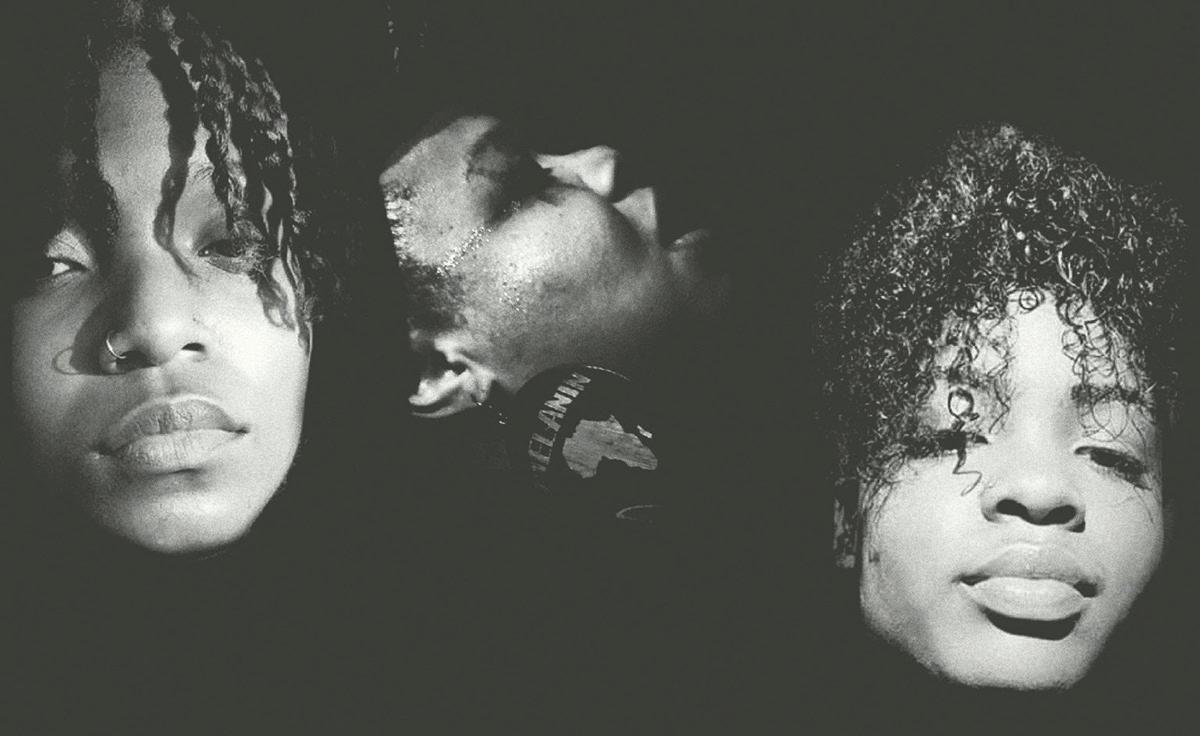
Joe Pratt & the Source One Band featuring Honeydew and New Orleans Beau A tribute to the band’s late lead guitarist, Sir Walter Scott. PUBLIC i opens. 7 PM, Odyssey East, 9942 S. Torrence. 21+ F
For years, until the pandemic shut everything down, the weekly shows hosted at the Odyssey East by bassist Joe Pratt and his Source One Band made the cozy venue one of the most important remaining strongholds of blues and soul-blues on the south side. Pratt’s resumé includes stints with the likes of Artie “Blues Boy” White, Otis Clay, and Johnnie Taylor, and his bandmates include keyboardist Stan “Preacherman” Banks (who formerly played with blues legend Koko Taylor) and drummer Lew Powell (who currently plays with R&B singer
Benny Latimore). At this show, they’ll lead a musical tribute to Sir Walter Scott, the Source One Band’s lead guitarist, who passed away last year. A member of one of the most important families in Chicago soul and R&B, Scott began his career during the doo-wop era; along with his brother Howard, he led some of the city’s finest show bands, most notably the World Band, who backed virtually every blues and soul-blues vocalist to appear in major south-side venues from the 1960s till the ’90s (and accompanied many of them on the road). Scott also became a first-call session man, appearing on myriad soul and R&B recordings. Over the decades, he worked with luminaries such as Bobby “Blue” Bland, the Manhattans, the Jackson 5, Natalie Cole, the Dells, Ike & Tina Turner, the O’Jays, Denise La Salle, Tyrone Davis, and the Chi-Lites (for whom he served as musical director).
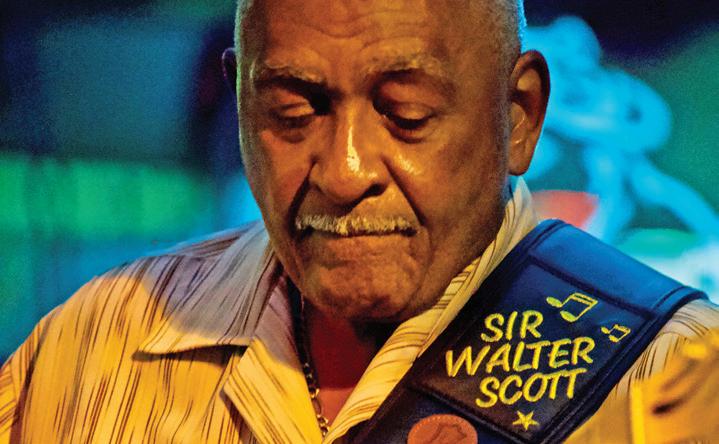
The featured vocalists at this tribute will be New Orleans Beau and Honeydew, two of Chicago’s premier soul-blues stylists. As if to acknowledge Scott’s irreplaceability, two guitarists will join the group for the night: Randell Mathews (formerly of the Albert King band) and Lee Holloway. The list of guest performers is subject to change, but among those confirmed according to Pratt are guitarist Max Valldeneu (World Band, Platinum) and a whole ra of singers: Marshall Thompson (founding member and former leader of the Chi-Lites), Gurtha Scott (Sir Walter’s niece), Vickie Baker, Lee Kirksy & Company, Louisiana Al, Joe Barr, Randy Johnson, and Jesi Terrell (formerly of the World Band and now a rising star in contemporary southern soul-blues). Howard Scott will be in attendance, and the Source One Band will honor his and Thompson’s musical legacies during their set. The evening also includes a special tribute to Sir Walter from PUBLIC i, who are returning to Chicago for the occasion; they currently work as a show band in Las Vegas, but Pratt has played with them for more than three decades. This is a free outdoor event with catering from Shirley Scott, who’s married to Howard. You’re welcome to bring your own chair, but no coolers are allowed—the bar will be open for drink service.
—DAVID WHITEISSistazz of the Nitty Gritty See Pick of the Week on facing page. 9 PM, Hideout, 1354 W. Wabansia, sold out. 21+
Pine Valley Cosmonauts Each show includes a conversation with bandleader Jon Langford and Virtue Cider founder Gregory Hall. 4:30 and 7 PM, the Hideout, 1354 W. Wabansia, both shows sold out. 21+
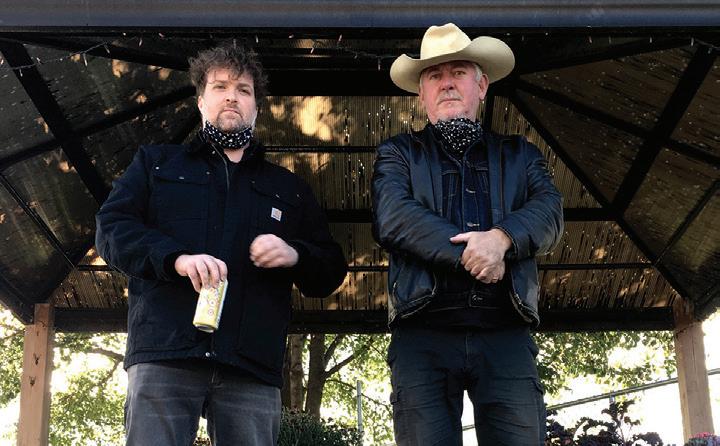
Led by Jon Langford of the Mekons and the Waco Brothers, Chicago alt-country band the Pine Valley Cosmonauts have covered plenty of ground in their quarter century or so of existence: they’ve made tribute albums for icons such as Bob Wills and Johnny Cash, spearheaded a series of death-themed covers compilations called The Executioner’s Last Songs, and provided backing for solo musicians, including Chicago folkie Kelly Hogan and Chumbawamba cofounder Danbert Nobacon. The ensemble’s latest endeavor is The Closing Time, a track-by-track interpretation of Tom Waits’s 1973 debut, Closing Time. In the Pine Valley Cosmonauts’ hands, the album’s melancholy ballads of reminiscence and regret feel like the perfect memorial for the times before the pandemic, and their evocations of lonely late nights and community arrive as a balm a er more than a year of isolation. (I know what the Hideout, which is hosting these shows, smells like at 6 AM—and I appreciate that knowledge more now than ever.) The Closing Time reminds us of some of the things we’ve been missing since venues were forced to close last spring: camaraderie with folks you don’t know well but keep seeing at shows, for instance, or the experience of having an intimate conversation with someone you’ve never seen in daylight, so that you don’t recognize them in the supermarket. Tom Waits was
only 24 when he made Closing Time, and it’s been argued that he hadn’t yet accumulated the weight of life experience to sing about what he did on that album. But the brilliant barfly talents present on this record certainly have put in the years, and not just collectively—joining Langford is a cast of alt-country and folk-rock royalty that includes Andrew Bird, Sally Timms, Jeff Tweedy, Rosie Flores, and Janet Bean. These shows, which will feature Langford, Bean, Timms, Bethany Thomas, John Szymanski, Rick Cookin’ Sherry, Nora O’Connor, and Dave Crawford, are benefits for the Chicago Independent Venue League (CIVL). Langford will also moderate Q&As with the show’s coproducer, Gregory Hall of Virtue Cider.
—MONICA KENDRICKDevin Shaffer Lipsticism opens. 6 PM, Sleeping Village, 3734 W. Belmont, $16, $14 in advance. 21+
Devin Shaffer spent her formative years searching for a sense of belonging as a performer—whether on a stage or in Chicago’s musical zeitgeist. In 2012 she found that elusive sense of communion seething from the PA at Cafe Mustache during a set by Haley Fohr of Circuit des Yeux. It encouraged Shaffer to think beyond the typical boundaries for women in music, and last month, nearly a decade later, she released her first album under her own name, a meditative montage of voice and found sound titled In My Dreams I’m There (American Dreams). From 2016 to 2018, Shaffer released whirring drone compositions under the name Yarrow, including a devastating 2016 slowcore collaboration with the Sister Grotto project of heaven- metal songwriter Madeline Johnston (who currently performs as Midwife). Shaffer’s atmospheric new material is far more driven by vocals and reflective of her idiosyncrasies—she’s a chronic daydreamer, for instance, and compulsively walks long distances. In My Dreams
is an ever-wandering sound study that feels like it’s in perpetual motion, untethered by earthly constraints. Shaffer transforms each song into a rousing panorama, whether she’s negotiating a wrong turn while cruising down back roads with a lover (“Drive Into Woods”) or wading in a transitory moment of desire (“Taste You With My Mouth Closed”). Using an arsenal of field recordings—clanging wind chimes, hissing waves, chirping birds—she melds mundanities into the wispy dreamscapes of her falsetto and humming guitar, a creeping collision not unlike the bleeding colors of a Rothko painting. Her first live performance of these ten new tracks will unfold on the Sleeping Village patio, with glitch-pop project Lipsticism opening. Onstage Shaffer uses her guitar, a pedal board, and turntables, creating a full sound by looping field recordings and manipulating vintage vinyl in real time. No matter how Shaffer chooses to approach re-creating In My Dreams for a live audience, she’s sure to conjure an atmosphere that is as sublime as it is fleeting.
—SHANNON NICO SHREIBAKArthhur, Occult Fractures
Self-released arthhur.bandcamp.com/album/occult-fractures
Chicagoan Mike Fox launched Arthhur a few years ago to explore any musical style he pleased. Multi-instrumentalist Matt Ciani, who plays with Fox in doom four-piece Flesh of the Stars, quickly joined the fold, and the two have since steered Arthhur through whimsical indie rock (2018’s come meet the opposite committee ), somber ambient (2020’s Let’s Go Piss in the Lake), and more. The best version of Arthhur thus far appeared on the December 2018 album Lost in the Walled City , thanks in part to sharp contributions from the band’s newest member, bassist and percussionist Luke Dahlgren. That release evokes the magic of early-2000s dance
continued from 35
punk with taut, twitchy instrumentation whose precision accelerates the music’s feeling of euphoria.

Arthhur’s self-released new album, Occult Fractures , disciplines the feral energy of Walled City while maintaining its intensity; a funky, serrated bass loop and a ceaselessly blinking synth sustain slow-burning opus “Antihistamine Money” through its quiet-before-the-storm lows and its crescendos fueled with kitchen-sink percussion. Arthhur enlisted five guest musicians to help tease out a more textured sound that leans into the boogie side of their dance-punk style—the sleek, scintillating title track, for instance, goes whole hog on disco, with warm keys, smooth-jazz guitar flourishes, gentle bass lines, and synthetic flute melodies. The songs concern themselves with more than gradations of genre and style, though; via their tongue-in-cheek lyrics they also bring lacerating critiques of media sensationalism (“Doom Journalism”) and aspirations born from lifestyle-marketing gimmicks (“Ripped and Dumb”) into their grooves. A great dance song can do more than simply get your body moving. —LEOR
GALILcanalirreal.bandcamp.com/album/s-t
If you went to a lot of shows at defunct Bridgeport punk house Rancho Huevos, you likely caught the July 2019 debut performance of south-side underground supergroup Canal Irreal. The band, whose name means “unreal channel” in Spanish, features members of razacore outfit Sin Orden (who emerged in a second wave of local Latinx punk bands in the late 1990s), guitarist Scott Plant of oddball postpunk unit Droids Blood, and longtime DIY punk linchpin Martin Sorrondeguy, best known as the fearless front man of radical Spanish-language hardcore champions Los Crudos and queercore evangelists Limp Wrist.
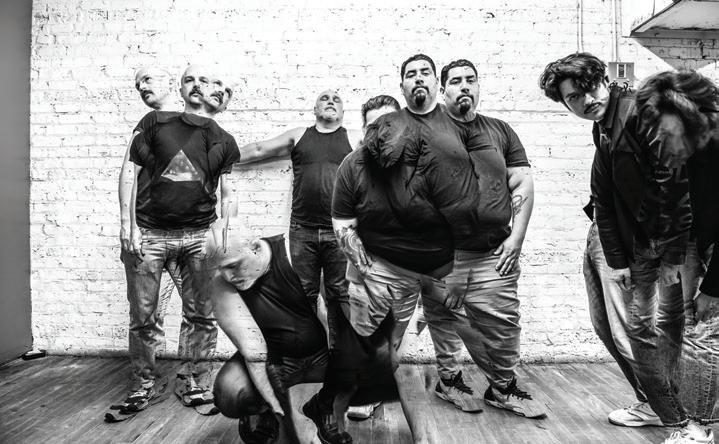
Almost two years after their first show, Canal Irreal have dropped their self-titled debut through
Beach Impediment Records from Richmond, Virginia. This sinewy sprint of an album plants its flag in the contested territory between grim, cold postpunk and white-hot hardcore fury. On “Glaze,” an austere bass line seems to summon icy guitars that act as foils to Sorrondeguy’s sawtooth screams; Canal Irreal can create tension that makes you want to jump out of your skin, so it’s a relief when when they crank up the chorus into a warm wall of sound. The quicksilver hardcore stomp of “Si Somos” and the brisk goth melody of “Knockdown” summon complex emotions with aggressive sounds, and make Canal Irreal ideal for repeat listening. —LEOR GALIL
Sandy Ewen, Keith Rowe, and Damon Smith / Gooseberry Marmalade, Houston 2012
Balance Point Acoustics / >X< sandyewen.bandcamp.com/album/houston-2012
The double album Houston 2012 captures a two-day encounter in October 2012 between English tabletop guitarist Keith Rowe and the experimentalmusic community of Houston, Texas. Rowe’s visit came about thanks to the initiative of Saint Louis double bassist Damon Smith, who lived in Texas at the time. While there Smith developed a strong working relationship with Sandy Ewen, who’s not only a splendid, unconventional guitarist but also an organizer committed to facilitating women’s access to the arts. In 2009 she established Lady Band (of Various Fruit Names), an all-female experimental ensemble whose political roots and widely varying experience levels bear similarities to the mixture of trained and amateur participants in the egalitarianminded Scratch Orchestra, an experimental-music ensemble Rowe had played in 40-odd years earlier.
The album’s first disc documents that convergence. First Rowe, Ewen, and Smith improvised a thrilling set of negotiations among Rowe’s finely abraded textures, Ewen’s more eruptive attack, and Smith’s groaning drones. Then a ten-strong Lady Band, using the name Gooseberry Marma-
lade, played a series of Scratch Orchestra scores that they’d workshopped with Rowe. Their performances reconcile rigor and playfulness, sounding by turns like a brawl in a metalworking shop, a convention of stocking-footed mimes, and a straight-up dance party. The second disc is just the trio, recorded when they reunited in the studio the next day. The resulting improvisations are much more austere than their first, reducing each musician’s signature sound to elemental expressions of electricity and friction enacted upon a vast field of sonic emptiness.
—BILL MEYERKoeosaeme, Annulus
Orange Milk
orangemilkrecords.bandcamp.com/album/annulus
Japanese producer Ryu Yoshizawa has a rich career that includes making music for business conglomerates Square Enix and Lotte, spending 17 years and counting in sound artists’ group Office Intenzio, and providing live support for synth-pop pioneers Ryuichi Sakamoto and Yukihiro Takahashi. His output as Koeosaeme has been varied too. His 2017 debut under that alias, Sonorant, features confetti-blasted footwork abstractions; 2018’s Float is all brooding drones and minimal electronics; and 2019’s Obanikeshi embraces full-blown sound-collage frenzy, with kaleidoscopic productions that often move at breakneck speeds. On his new record, Annulus (Orange Milk), he dials things back, pairing glossy instrumentation with sparse arrangements; each track is deliberate, unhurried, and above all lush. There’s a greater sense of continuity than on his previous releases, largely due to how spacious and airy each song feels. This lightness is key, causing every small sonic variation to feel like a crucial development, and “1520219:44” provides the album’s first taste of such economical sound slinging. Atop winding percussion and the faintest of ambience, a flurry of mouth noises—clicks and spurts and spitting—creates blissed-out reveries in a dizzying array of flavors. “12520219:05” is more straight-ahead in
its dreaminess, adorning synth pads with Harold Budd-esque piano ambience, but even as the song gets busier, a sustained string note reins it in. This sort of careful balancing act defines every track, and it’s necessary to maintain the overarching playfulness of Annulus. Yoshizawa’s charming way of handling MIDI instrumentation throughout the album— mirroring percussion and vocals on “2720217:06,” for instance, or marrying electronic blips with a lumbering beat on “122202115:12”—elevates these tracks from mere curios into fleshed-out explorations of density, rhythm, and timbre. He also brings a beautiful mix of the traditional and the contemporary into play, with throat singing and various Asian percussion instruments melding with retrofuturistic synth flourishes on “1214202018:07.” Yoshizawa constantly aims to surprise, and with Annulus, he does so while delivering a cohesive vision. —JOSHUA
MINSOO KIMIzzy True, Our Beautiful Baby World Don Giovanni izzytrue.bandcamp.com/album/our-beautifulbaby-world
Izzy Reidy specializes in the kind of intimate indie rock where you can hear the sound of fingertips squeaking along guitar strings. They launched their band, Izzy True, while living in upstate New York, but these days Reidy lives in Chicago and plays with drummer Sam Goldstein and multi-instrumentalist Curtis Oren. Izzy True’s new third album, Our Beautiful Baby World (Don Giovanni), melds homespun rock and relaxed country swagger; on “Angel Band,” Oren dispenses a spry walking bass line that boosts Reidy’s intensifying vocals toward the song’s fiery, calamitous closing notes. As a front person, Reidy balances stage-ready poise with down-toearth informality, exuding a quiet grace that amplifies their incandescent whispers. Our Beautiful Baby World conjures an inviting sense of comfort while sending out lightning bolts at just the right moments—and each shock makes it clear that this is a band to see in the flesh. —LEOR
GALIL v[Werber], was in a couple of other projects as well, and he sent me an e-mail from this group called Lovely Little Girls. I thought, “That’s an odd band name.” And Charlie said, “They need a keyboard player.” And I was like, you know, Charlie, I appreciate the offer, but I kind of want nothing to do with music right now; I’m trying to rebuild myself. And then they found a keyboard player, and then there were some more persistent e-mails to me asking, “Well, will you sing backup?”
So I asked for a demo CD. My mom had given me a Panera gift card. I walked about 45 minutes to a Panera with the CD and a laptop and sat there listening and eating salad. Lovely Little Girls has some rather ribald lyrics. I was listening, thinking, “What on earth is going on here?” And then I said out loud, “What the fuck?” It just kind of came out of my mouth.
memories of failing spectacularly at that sort of thing, but I think I’m at a point where I can go, “Well, maybe like a Balkan-style harmony would make sense over this, and then this sort of progressive underpinning with an R&B bass line . . . ” I’m not typically composing in the sense of music theory; I can, but I want to assemble things as if I’m storyboarding in my head. In a way, I feel like a casting director for sound.

“I want to assemble things as if I’m storyboarding in my head. In a way, I feel like a casting director for sound.”
As told to SALEM COLLO-JULIN
Sacha Mullin, 32, is a singer-songwriter and pianist who teaches voice and piano to private students and works as an administrative assistant for Peter McDowell Arts Consulting. He has performed with the bands Lovely Little Girls and Cheer-Accident, and he’s released two albums of his own music, 2013’s Whelm and 2017’s Duplex
Imostly grew up in Minnesota. I was there for about 18 years, and then around 2011 I decided to move to Chicago. I love New York dearly, or at least the idea of what New York was—it’s permanently crystallized in my head as the Seinfeld era—but New York is very di erent now. I had thought, well, you know, Minneapolis is sort of Cindy Brady and New
York is Marcia, so I’ll move to Jan. You know, Chicago.
I got an apartment on Craigslist and prayed that the people who lived there weren’t going to murder me. They ended up being friendly and fine. And it was because of them that I attended a weird dinner party and met [Quimby’s manager] Liz Mason, who’s now a dear friend of mine. Liz and I now do The Found *NSYNC Fan Fiction Radio Hour , a podcast where we read *NSYNC fanfiction that was found in a binder in a Goodwill.
I did know a few people in Chicago before I moved here—a band from Minneapolis called Guzzlemug. I went to college with two of the three members. And I was like, “Well, I know you. Let’s hang out.” The drummer, Charlie
I’ve always kind of been the person that wanted to conquer different challenges, and I’m glad I just fell into this band without any context. I just said to myself, “Yeah, I’ll sing these really acrobatic lines.”
I ended up making two records with them and toured a couple of times. It taught me a lot about myself as a singer. I felt like a Swiss Army knife. It’s amazing that in that band we were able to somehow distinctively bring our own sounds. You have a group of nine very idiosyncratic people, all very di erent, and it somehow coalesced into this really interesting music.
My folks were involved in church music, like from the Catholic angle. My mom was always playing this one cassette tape of Sandi Patty’s “Pour On the Power.” I can’t with that song. My mom is a great singer, and she often had jobs at churches as the music or choral director. So I learned the harmony style of Catholic music kind of through osmosis, which is great from a music-theory standpoint. I hit “cancel” when it came to Catholic confirmation—I was done after the free trial. But, you know, those formative sounds are always with you.
One particular memory I have from childhood is hearing the end credits to the Coneheads movie, and Morten Harket from A-ha sings a Frankie Valli song (“Can’t Take My Eyes O You”). And I just remember thinking, “How do I get to be a disembodied voice over the credits for a movie?”
I’m attracted to things on the margins. I can put a couple of weird things on a plate, and it makes sense to me. I definitely have a lot of
During the COVID lockdown period, I felt like there were times that my heart stopped—there were moments where things fell apart because we couldn’t be near anyone. There was a reunion of an old band that I was involved in, and we got pretty far in the recording stages of a project and it just all fell apart—the energy was gone, the mojo was gone. I had a relationship I was in that fell apart because of the distance.
But limitations always create opportunity when you get over the sulking. The benefit was that I focused on my apartment that I’ve been in for eight years and realized, “This isn’t just a stopping point; maybe you should finally unpack a couple of boxes.” I bought a nice mirror and I assembled a desk, and now it looks like I live in a Michaels. So, small things.
And I was working—I was teaching voice, and I had been working as an administrative assistant for a long time. I also work with Darien Williams at Cafe Mustache, putting together events (filmed live and streamed on Twitch during the pandemic). Thankfully we’re now in a time and space where a “live studio audience” is welcomed back in, and the support has been great.
I was able to finish a record that I started a couple of years ago with Todd Rittmann [of Dead Rider]. Todd is a very good friend of mine and an absolute goo all. I think that we’ve made something really cool. And I am elated that I was recently signed to Dog & Pony Records, who are scheduled to release my album with Todd early next year. They might help me release a digital reissue of my 2017 album Duplex as well.
If someone asks me to sing backup, I am there. It’s my favorite thing to do—resonating against someone else’s voice. But I’m excited about this new record with Todd. It’s really great to feel like I’m in my own skin with this record.
Honey Cellar 7/15, 6 PM, Montrose Saloon F
The Hu 10/13, 7:30 PM, Park West, 18+
In the Company of Serpents, Hive, Roman Ring 9/4, 9:30 PM, Empty Bottle
Iris Temple, Bonita Appleblunt (DJ set) 7/20, 9 PM, Hideout
JukeBox Heroes 7/21, 5:30 PM, Martyrs F
Cassandra Kaczor 7/16, 9 PM; 7/18 and 7/25, 3 PM, Tack Room F
Dennis J. Leise 7/16, 7 PM, Blue Island Beer Company, Blue Island F
Lil’ Ed & the Blues Imperials 7/16-7/17, 9 and 11 PM, Rosa’s Lounge
Little Church, Cold Beaches, Reno Cruz 7/16, 8 PM, Schubas
Tony Lucca 8/15, 7 PM, SPACE, Evanston b
Afro Fusion DJs 7/15, 7/22, and 7/29, 9 PM, Le Nocturne Chicago
AG Club, Payday 7/29, 11 PM, Bottom Lounge, 17+
Alex G, Exum 11/20, 8 PM, Metro, 18+
All Time Low, Chloe Moriondo
7/28, 7 PM, Bottom Lounge b
Alyssa Allgood 7/15, 8 PM, Montrose Saloon F
Altan 10/31, 7 PM, Maurer Hall, Old Town School of Folk Music b
Ashe, Jake Wesley Rogers
7/30, 11 PM, Lincoln Hall, 18+
Bayside, Senses Fail, Hawthorne Heights, Bombpops
9/19, 9 PM, Concord Music Hall, 17+
Beach Fossils, Wild Nothing, Hannah Jadagu 10/6-10/7, 8 PM, Thalia Hall, 17+
Christy Bennett’s Fumée 7/17, 9 PM, Hungry Brain
Big League Boys 7/23, 9 PM, Beat Kitchen
Michelle Billingsley 7/16, 9:30 PM, Hideout
Bitchin Bajas 7/23, 8:30 PM, Constellation, 18+
Black Coffee 10/9, 9 PM, Riviera Theatre, 18+
Blood People, Aweful, Boybrain 7/17, 10 PM, Liar’s Club
Bongzilla, Bridge City Sinners
8/27, 7:30 PM, Beat Kitchen b
Bonnie “Prince” Billy with Emmett Kelly, Jonathan Richman featuring Tommy Larkins 10/9, 6:30 and 10 PM; 10/10, 5:30 and 9 PM, Constellation, 18+
Box Tops, Pete Muller & Kindred Souls 7/21, 8 PM, City
Winery b
Rylan Brooks, Dan Whitaker
10/2, 8 PM, Phyllis’ Musical Inn
Marc Broussard 7/18-7/19, 8 PM, City Winery b
Sons of the Never Wrong 9/17, 7 PM, American Legion Hall
Post 42, Evanston
Jason Stein Trio 7/31, 8:30 PM, Constellation, 18+
Sunshine Boys, Bobbleheads
7/29, 7 PM, SPACE, Evanston b
38 Special 12/10, 8 PM, Arcada Theatre, Saint Charles b
Yann Tiersen, Charlie Cunningham 11/17, 8 PM, Metro, 18+
Cactus Blossoms 7/16, 8 PM, City Winery b

George Arthur Calendar 7/21, 6 PM, Tack Room F b
Cash Box Kings 8/14, 8 PM, SPACE, Evanston b
Catcher, Been Stellar, Zilched
7/24, 8 PM, Schubas, 18+
Cautious Clay, Joy Oladokun
7/30, 11 PM, Bottom Lounge, 17+
Harry Chapin 40 Year Anniversary: A Celebration of Life featuring Tom Chapin, Jen Chapin Trio, Chapin
Sisters, Big John Wallace, Howard Fields 7/19, 7 PM, livestream at citywinery. com b
Chicago Soul Jazz Collective
7/21, 8 and 10 PM, Jazz Showcase b
City and Colour 9/27, 8 PM, Thalia Hall, 17+
Brent Cobb, Nikki Lane, Andrew Combs 8/20, 7:30 PM, Thalia Hall, 17+
Colombian Fest Chicago day one featuring Charlie Cardona, Alzate, Javier
Vasquez, Kevin Florez, Nesi, Edgar Joel, Anne Gil, Monica
Restrepo 7/24, noon, Humboldt Park b
Colombian Fest Chicago day two featuring Oscar D’Leon, Nelson Velasquez, La Sonora
Dinamita, Anthony “La
Makina” Maldonado, Lucho
Morales y Su Fiesta Vallenata
7/25, noon, Humboldt Park b
Mondo Cortez & Chicago
Blues Angels 7/18, 8 PM,
Montrose Saloon F
Davina & the Vagabonds 7/15, 8 PM, City Winery b
Dinosaur Jr. 9/18, 11 PM, Bottom Lounge, 17+
Dirty Disco featuring Azzecca, Jaygee, Helang, Huxley 7/16, 10 PM, Spy Bar
Dixon, Âme 7/23, 10 PM, Radius
Chicago
Dolly Varden 9/3, 7 PM, American Legion Hall Post 42, Evanston
Aaron Dorfman 8/12, 5:30 PM
Martyrs’ F
Duffle Bag Buru, Goldenboymnny, Ransah, Kiltxty 7/23, 9 PM, Schubas, 18+
Duke, Brandon James, Gone Fishing 7/18, 6 PM, Reggies Music Joint
Dustin Laurenzi’s Natural Language, Christopher Moore & Adam Shead 7/18, 9 PM, Hungry Brain Earthgang, Benji. 7/31, 11 PM, Bottom Lounge, 17+
Eleventh Dream Day 9/24, 8:30 PM, Constellation, 18+ Emotional Oranges 9/28, 8 PM, Thalia Hall b
Noga Erez 10/13, 8 PM, Thalia Hall, 17+
Essenger, Young Medicine, Night Spice 8/13, 7 PM, Reggies Rock Club b
Evil Empire, Public Serpents, Shitizen 7/17, 9 PM, Reggies Music Joint
Ferguson, Carbone, & Peck 7/20, 8 PM, City Winery b
Front Bottoms, Sincere Engineer 7/31, 11 PM, Lincoln Hall, 18+
Funtcase, Doctor P 7/16, 9:30 PM, Concord Music Hall, 17+
Grant Park Orchestra 7/16-7/17, 6:30 PM, Pritzker Pavilion, Millennium Park b
Gerrit Hatcher, Keefe Jackson, Peter Maunu, and Julian Kirshner 7/22, 8:30 PM, Elastic b
Heavy Sounds, Marisol La Brava & A Flor de Piel, DJ Ryan Norsworthy 7/22, 6 PM, Kosciuszko Park F b
Anne Hills, Fred Simon 8/15, 1 PM, SPACE, Evanston b
Masked Intruder 7/24, 10 PM, Beat Kitchen, 17+ Del McCoury Band 11/7, 5 PM, Maurer Hall, Old Town School of Folk Music b
Mod Sun, girlfriends, Tyler Posey 9/17, 7:30 PM, Park West b
Typhanie Monique 7/25, 7 PM, SPACE, Evanston b
Thurston Moore 9/14-9/15, 9:30 PM, Empty Bottle
Buffalo Nichols 7/23, 8 PM, SPACE, Evanston b
Nocturna’s 33 Year Anniversary with DJ Scary Lady Sarah 7/17, 10 PM, Metro, 18+ Of Montreal; Locate S,1 11/15, 8:30 PM, Lincoln Hall, 18+ Ohmme 8/26, 8:30 PM, Thalia Hall, 17+
Opera Festival of Chicago presents Il Tabarro 8/5, 7 and 9 PM, Thalia Hall b
Outronaut 7/18, 6 PM, Montrose Saloon F
John Primer & the Real Deal Blues Band 7/24, 9 and 11 PM, Rosa’s Lounge Princess Nokia, Riz La Vie 8/1, 11 PM, Lincoln Hall, 18+ Psychostick, Downtown Brown 7/23, 9 PM, Subterranean Quartet in the Parks 7/15, 6:30 PM, Harrison Park F b
Quicksand 10/5, 8 PM, Metro, 18+
Red Fang, Starcrawler, Warish 11/11, 9 PM, Metro, 18+ Rock and Roll Playhouse presents the Music of Grateful Dead for Kids 8/15, 11:30 AM, Thalia Hall b
Rogue Parade 7/15-7/17, 8 and 10 PM; 7/18, 4 and 8 PM, Jazz Showcase b
Jeff Rosenstock; Slaughter Beach, Dog; Oceanator 11/12, 7 PM; 11/14, 7 PM, Metro b
Sanctified Grumblers 7/15, 8 PM, Hideout
Sincere Engineer, Canadian Rifle, Annabel, Foresight
9/10, 8 PM, Cobra Lounge, 17+ Slow Pulp, Girl K 12/17, 9 PM, Lincoln Hall, 18+
Tiny Horse Trio featuring Gerald Dowd 7/25, 4 PM, FitzGerald’s, Berwyn F b
Tiny Horse Trio 7/24, 1 PM, Martyrs F b
Too Many Zooz & Big Freedia
9/18, 11 PM, the Vic, 18+
12th Planet 8/27, 9 PM, Concord Music Hall, 18+
Tyga, Bankrol Hayden, BRS
Kash, Metro 7/16, 8 PM, Radius Chicago, 18+
Colter Wall 9/30, 8 PM, Thalia Hall, 17+
Dan Whitaker & Earl Powers
7/15, 7 PM, Phyllis’ Musical Inn F
White Ppl, New House, Partywatcher 7/23, 9 PM, Sleeping Village
Wicker Park Fest featuring Archers of Loaf, Ric Wilson, Smoking Popes, Masked Intruder, Wyatt Waddell, Marina City, ÉSSO, Slow Mass, Mother Nature, Thegr8thinkaz, No Men, and more 7/23, 5 PM; 7/24-7/25, noon, North and Damen b
Wiz Khalifa, Gashi, Chevy Woods, Gordo 7/17, 8 PM, Radius Chicago, 18+
Armor for Sleep, Never Loved, Silence of You, Cold Seas 9/10, 7 PM, Metro, lineup updated b
Out of Space presents Caamp, Madi Diaz 8/8, 7 PM, Canal Shores Golf Course, Evanston, opener added, 18+
Out of Space presents Ben Harper & the Innocent Criminals, Jake Etheridge 8/7, 7 PM, Canal Shores Golf Course, Evanston, opener added, 18+
Manwolves, Kari 7/22, 8:30 PM, Thalia Hall, opener added, 17+
Tame Impala 9/7, 8 PM, United Center, rescheduled b
Wardruna 10/21/2022, 8:30 PM, Auditorium Theatre, rescheduled b v
SINCE LEAVING Gossip Wolf in 2012, music journalist Jessica Hopper has really hit the skids. In the years since, she’s been reduced to writing and editorial work for bit players MTV News, Spotify, and Pitchfork, among others (and hosting a season of KCRW’s award-winning podcast Lost Notes). Sad! This week she’s publishing a revised and expanded edition of her 2015 book, The First Collection of Criticism by a Living Female Rock Critic, with a foreword by Samantha Irby , heaps of previously uncollected material, and a touchingly autobiographical afterword. Hopper’s virtual book tour includes three dates this week, including a discussion on Thursday with critic Greil Marcus, and on August 26 she’ll participate in a Chicago Reader Book Club event.
Local tunesmith Elliot Korte , who records as Bryan Away , comes from a clan with chops—his parents have both been working musicians (they’ve collaborated with the likes of Paul Simon, Rubén Blades, and Willie Colón), and his grandfather is composer Karl Korte, who’s won two Guggenheim Fellowships. On his new album, Canyons to Sawdust (due Friday, July 9), Korte adorns gilded folk-pop with lush orchestration and breathy backup vocals. Standout tracks include “Dreams & Circumstance,” which features vocals from Half Waif, and “Scenes From a Marriage,” whose sweet guitar arrangement is undermined by grimly poignant lyrics.
On Monday, Art on the Mart debuted a new collection of nighttime projections on the side of the Merchandise Mart. It includes Footnotes , an animated celebration of footwork directed by Brandon “Chief Manny” Calhoun (cofounder of the Era ) and scene documentarian Wills Glasspiegel Teklife cofounder DJ Spinn put together the short film’s music, with contributions from Angel Bat Dawid , the Chicago Bucket Boys, and Elisha Chandler and Amal Hubert from Hypnotic Brass Ensemble. Footnotes runs till September 16. —J.R. NELSON AND LEOR GALIL
Got a tip? Tweet @Gossip_Wolf or e-mail gossipwolf@chicagoreader.com.

More than 50,000 copies will be available at nearly 1,200 locations across the city and suburbs.

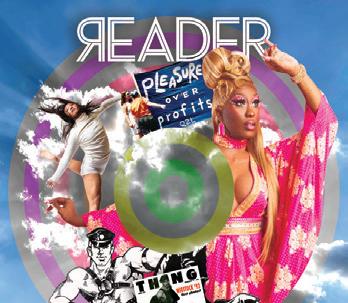
Upcoming Issues:


July 22, 2020


Aug. 5, 2021

Aug. 19, 2021
Sept. 2, 2021
Sept. 16, 2021
Sept. 30, 2021
Oct. 14, 2021
Oct. 28, 2021
Nov. 11, 2021

Nov. 25, 2021
Dec. 9, 2021

Dec. 23, 2021
Cannabis Special Section
Year of Chicago Music + Food Issue
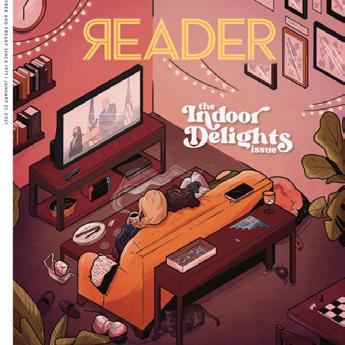
Music Issue: Festival Guide + Windy City Times Insert
Fall Arts Preview

50th Anniversary Issue 1
50th Anniversary Issue 2
Cannabis Special Section
Nonprofit Issue Drinks Issue + WCT Insert Year in Review


Q : I am familiar with demisexuality—the idea that some people cannot develop a sexual relationship without an emotional or a romantic bond first—but what about the opposite phenomenon? I lose interest in people who get to know me and my desire to hook up is quickly replaced by a desire to just be acquaintances.

SAVAGE LOVE
Questions from “Sack Lunch,” an online hangout exclusively for Magnum subscribers to the Savage Lovecast
By DAN SAVAGEQ : My son is straight, cute, accomplished, 25, and has friends. He’s never been kissed. I suspect he’s terrified. I can’t talk to him about it. Should his dad talk to him? Should he go to a sex worker? Would this undermine his confidence?
A : Your son has friends and that’s a good sign. Not only does it mean your son has social skills, mom, it means he has people in his life that he can confide in about his sex life and ask for advice. You can and should ask him if there’s anything he would like to talk about—keep those lines of communication open—but it’s entirely
possible that your son has no interest in sex (he could be asexual) or that he has an active love and/or sex life that he doesn’t wanna talk with mom and dad about for reasons, e.g. he’s someone’s rubber gimp or he can only get it up in a fursuit or he’s in a polyamorous triad that he’s not ready to tell you about. If he’s happy, let him be.
Q : Is there a safe way to enlarge a clitoris?
A : Allow me to Google that for you. Hey, turns out there’s a Wikipedia entry for that (“Clitoral Enlargement Methods”), as I suspected there might be, and it lists
three methods to grow a clitoris: the use of creams containing testosterone (applied directly to the clit); testosterone supplements (administered by injection); and the use of clitoral pumps, i.e. suction cups. Testosterone injections are the most effective way to enlarge a clit—as any trans man can tell you—but it has other “masculinizing effects” that you may not want. Clitoral pumps, much like penis pumps, can enlarge the clitoris temporarily but overuse or too-enthusiastic use of a pump—on a dick or a clit—can damage erectile tissues.
A : Not only is there a term for people like you—people who lose desire a er getting to know someone—there’s also a pride flag because there can never be too many pride flags: “Fraysexual, also known as ignotasexual, is a sexual orientation on the asexual spectrum,” says LGBTA Wiki, “[describing] someone who only experiences sexual attraction towards those that they are not deeply connected with and lose that attraction as they get to know the person.” Your pride colors are blue, cyan, white, and gray. (There are so many pride flags out there these days—and they come out so damn fast— that I suspected someone created an online pride flag generator. And I was right: myflag.lgbt.)
Q : What does “being in good working order” mean in practice? I’m struggling with depression (got diagnosed 18 months ago) and I still don’t have a handle on things. I feel like I can’t date because I can’t even tell potential partners what brand of chaos to expect with me because I don’t know myself. My friends say I’m being too hard on myself. What do you think?
A : I don’t have a handle on things. Not all the things. I have my own struggles and I bring my own particular brand of chaos to the table,
the bedroom, the play party, etc. But I like to think I’m in good working order— or good enough working order. I realize this is circular logic but one of the ways I know I’m in good enough working order to sustain a relationship is that I’m in relationships I’ve somehow managed to sustain. So if someone decides they wanna be with you—someone who has a choice about staying or going—then that person believes you’re in good enough working order. That’s a “yes” you can and should take for an answer, but it’s not a “yes” you’re ever gonna get if you never allow yourself to date. At some point you have to take a chance—probably more than one chance—to find out whether or not you’re in good enough working order. I think it’s a good sign that your friends—people who know and love you—feel like you’re in good enough working order to get out there and start dating. (I realize that the ability to sustain a relationship isn’t, in and of itself, proof that a person is in good working order. Some relationships are toxic, abusive, codependent, etc. Getting out of a bad relationship, staying in a good one—either can be evidence that a person is in good working order.)
Q : Long distance relationships . . . how do you choose between moving overseas to another country, uprooting your life for a relationship, and staying close to family and friends and the familiar? I moved to the UK before the pandemic hit and I’m trying not to blame the relationship for a shit year where I wasn’t able to leave home or make new friends in a new country. We were together for one year
before I moved here. I miss home and friends, I lost my dad, and I’m terrified that this relationship might fail at some point a er we’ve started a family. And then I’ll be stuck in this country to be near my children. Yes, I’m in therapy. But I think I need a Dan Savage reality check.
A : I’m so sorry for the loss of your father. I would advise you to take a deep breath— several dozen a day—and give it another year. Once you’re able to get a job and make some new friends you’ll gain some clarity. If things are good and you’re feeling more at home, great. Stay in the UK. But if you’re still miserable and full of doubt, well, then you might want to end the relationship and head home. In the meantime you’re going to wanna stay in therapy and make sure you’re using the most effective form of birth control you can get your hands on—which is available free from the UK’s National Health Service. (And I don’t want to be a downer here or tip the scales . . . but there’s no way to eliminate the risk of a relationship ending or failing a er you’ve started a family. Or before you’ve started a family.) v
Magnum subscribers to the Savage Lovecast enjoy ad-free versions of the show with more guests and more questions, access to the full archive of shows, the monthly Sack Lunch virtual hangout—where my listeners get to give sex advice—and other bonus content. To subscribe to the Savage Lovecast go to savagelovecast.com and click subscribe.
Send letters to mail@ savagelove.net. Download the Savage Lovecast at savagelovecast.com. @fakedansavage










































Book Club members receive an additional 10% off at the following stores:
The Book Cellar | 4736 N. Lincoln 60625 773-293-2665 | bookcellarinc.com
Bookie’s | 10324 S. Western 60643 312-890-3860 | bookiesbookstores.com
Bucket O’Blood Books and Records | 3182 N. Elston 60618 312-890-3860 | bucketoblood.com
The Dial Bookshop | 410 S. Michigan, 2nd Floor 60605 dialbookshop.com
Madison Street Books | 1127 W. Madison 60607 312-929-4140 | madstreetbooks.com
Pilsen Community Books | 1102 W. 18th St. 60608 312-478-9434 | pilsencommunitybooks.com
Roscoe Books | 2142 W. Roscoe 60618 773-857-2676 | roscoebooks.com
Semicolon | 515 N. Halsted 60642 312-877-5170 | semicolonchi.com
Seminary Co-Op Bookstore | 5751 S. Woodlawn 60637 773-752-4381 | semcoop.com

We’re continuing the conversation! Watch for the next Reader Cannabis Conversations on August 5, 2021


Space is limited. Reserve your spot now. For more information, contact ads@chicagoreader.com

Volumes Bookcafe | 1474 N. Milwaukee 60622 773-697-8066 | volumesbooks.com
Women & Children First | 5233 N. Clark 60640 773-769-9299 | womenandchildrenfirst.com

This yearlong partnership with independent bookstores is supported by the Poetry Foundation.



Mikki Kendall
Hood Feminism: Notes From the Women That a Movement Forgot
Author Talk: Oct. 22, 2020
Sonali Dev Recipe for Persuasion
Author Talk: Nov. 19, 2020
Riva Lehrer Golem Girl
Author Talk: Dec. 17, 2020
Emil Ferris My Favorite Thing Is Monsters
Author Talk: Jan. 28, 2021
Eve Ewing
1919
Author Talk: Feb. 25, 2021
Nnedi Okorafor Remote Control
Author Talk: Mar. 25, 2021
Natalie Moore
The South Side
Author Talk: Apr. 22, 2021
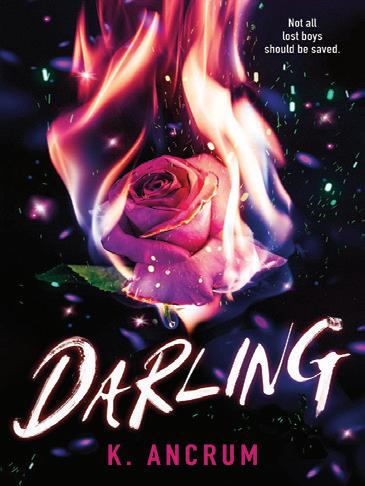
Rebecca Makkai
The Great Believers
Author Talk: May 26, 2021
Fatimah Asghar
If They Come for Us
Author Talk: June 24, 2021
Kayla Ancrum Darling
Author Talk: July 22, 2021
Jessica Hopper (TBD)
Author Talk: Aug. 26, 2021
Precious Brady-Davis I Have Always Been Me: A Memoir
Book Club membership includes: Exclusive access to conversations between Authors and the Reader Discounts to your favorite independent bookstores




A curated monthly newsletter A members-only discussion forum Special offers from Reader partners





K. Ancrum is the author of the award-winning thriller The Wicker King, a lesbian romance; The Weight of the Stars; and the upcoming Peter Pan thriller Darling. Ancrum is a Chicago native passionate about diversity and representation in young adult fiction. She currently writes most of her work in the lush gardens of the Chicago Art Institute.
Presented by:
Author Talk: Sep. 23, 2021 Learn
Presented by:
Karen Hawkins is co-editor in chief of the Chicago Reader. She is also the owner and founder of feminist media company Rebellious Magazine for Women. Her journalism background includes positions with the Associated Press and the Windy City Times
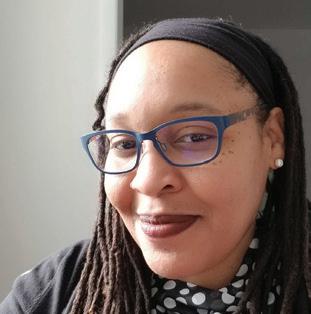
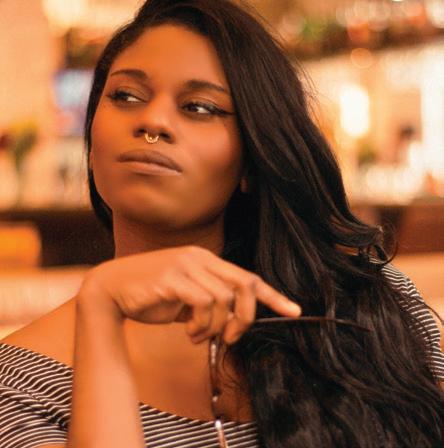

... beautifully captured in this 12”x12.5” poster by Jason Frederick celebrating 2020 (and 2020 being over).
This artwork originally appeared on the cover of our March 18, 2021 Best of Chicago issue.








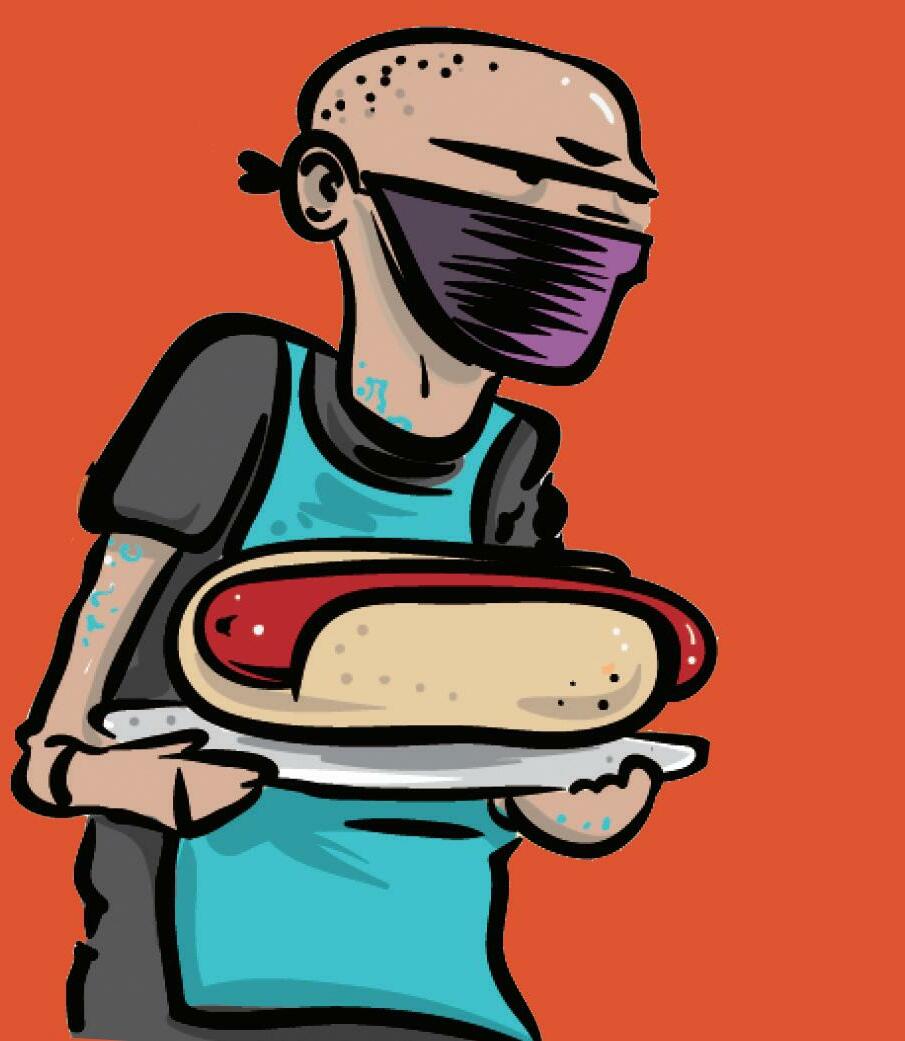


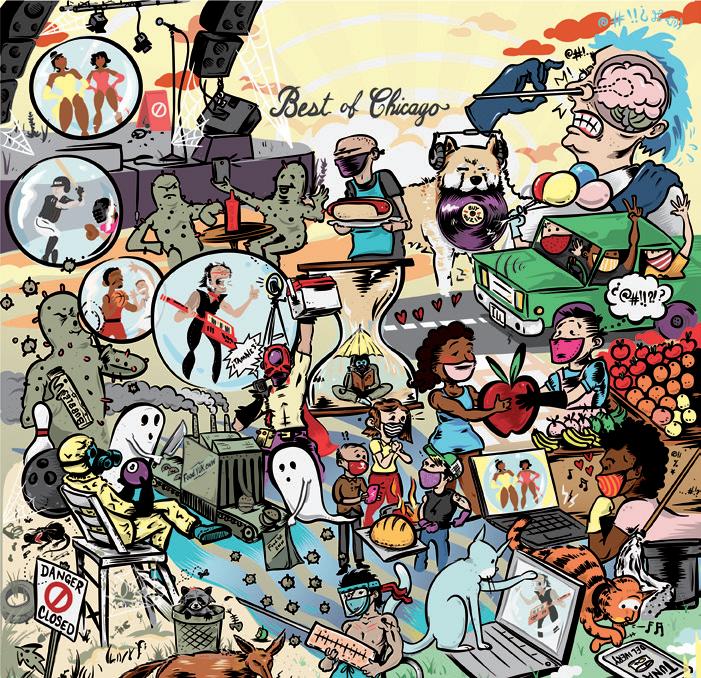












chicagoreader.com/store




Chicago Chop Shop Salon is Hiring!
Established in October 2010, Chicago Chop Shop Education Salon has been catering to a diverse clientele since its inception. Looking to Fill multiple positions in our Wicker Park studio. Employed Stylists/ Barbers, Independent Stylists/ Barbers, Front Desk/ Shampoo Assistance (licensed) are welcome to apply. We supply education, software, products and tools needed to provide modern hair services. email us your resume today and schedule an interview for tomorrow! chicagochopshop@gmail.com
Northwestern Memorial Healthcare seeks Genetic Counselors for Chicago, IL. Master’s in Genetic Counseling req’d. Req’d: ABGC certified or eligible req’d. IL GC license (or temp license) req’d.
Background check & drug test req’d Apply online: https://smrtr. io/5THrF. Requisition ID:
REF20038A EOE
ADMINISTRATIVE
SALES & MARKETING
FOOD & DRINK
SPAS & SALONS
BIKE JOBS
GENERAL REAL ESTATE RENTALS FOR SALE
NON-RESIDENTIAL ROOMATES
MARKETPLACE
GOODS SERVICES
HEALTH & WELLNESS INSTRUCTION
MUSIC & ARTS
NOTICES
MESSAGES
LEGAL NOTICES
ADULT SERVICES
Northwestern Memorial Healthcare seeks HRMS Business Analyst for Warrenville, IL to provide functional knowledge, implementation & support for systems for a large healthcare system, including config and dev of ad-hoc report in HR Mgmt System. Bachelor’s in Comp Sci or IT +3 yrs exp req’d. Req’d Skills:
3yrs w/ functional analyst in HR; PeopleSoft HCM: Benefits, Payroll, Workforce Administration; People Tools; People Code; PS Queries, SQL Developer; Query Manager; Component Interface; Application Engine; SQR; Integration Broker; Application Messaging; Workflow; XML Publisher. Apply online: https:// jobs.smartrecruiters. com/NorthwesternMedicine/743999758087129
-hrms-business-analystfull-time Requisition ID: REF20452Z EOE
Northwestern Memorial Healthcare seeks Sr. Application Analysts for Chicago, IL to provide technical project leadership.
Bitsio Inc. seeks Bachelor’s + 2yrs exp/equiv.: Splunk Developer (BSD21): HFM, FCM, ERP, DRM, FDMEE and ODI interfaces. Mail resume with job ID # to HR: 920 South Spring Street, Suite 1200, Springfield, IL 62704. Unanticipated work site locations throughout U.S. Foreign equiv. accepted.
Northwestern Memorial Healthcare seeks Systems Engineers for Chicago, IL location to provide tech guidance & support for computing systems & systems integration. Bachelor’s in Comp Sci/Electronics Eng/related field +5yrs exp req’d. Requires: 3yrs w/Design, troubleshoot & configure infrastructure & Windows Architecture; Linux; implement & troubleshoot VMware; VMTools; SCCM administration (incl Security roles); Group Policy; VSphere; Power Shell; SQL Query. Req rotating 24hr on call availability. Background check & drug test req’d. https: //smrtr.io/5X2Q4.
Requisition ID: REF20302R EOE
Northwestern Memorial Healthcare seeks Sr. Architect for Chicago, IL to provide facilitation, analysis, design, & execution of solution architecture . Bachelor’s in Comp Sci/IT/Stats+3yrs exp OR Bachelor’s in any Eng field+5yrs exp req’d. Req’d Skills: 3yrs w/BI dev in OLTP, OLAP & DSS; SQL queries; dev, design & support SQL Server; Tableau; SSIS; SSRS; SDLC w/ structured programming; healthcare analytics; stored procedures; web services; relational & dimensional data modeling. Background check & drug test req’d. https:// smrtr.io/5X2Y8. Requisition ID: REF20301L EOE
Bachelor’s in Comp Sci/ Apps or Info Tech+7yrs exp req’d. Req’d Skills: 5yrs w/ PeopleSoft FSCM in healthcare/ins;
2yrs w/ each: PeopleSoft
FSCM: GL, AP, AM, AR, Billing, project costing, Purchasing, IM; People Code; App Engine; Integration Broker; Messaging; Component Interfaces; XML Publisher; SQL; SQR; PUM; PeopleSoft upgrades, incl. fit/gap analysis & retrofitting customizations. Background check & drug test req’d. Apply online: https:// jobs.smartrecruiters. com/NorthwesternMedicine/743999758155470
-sr-application-analysts-full-time-days. Requisition ID: REF20455D
EOE
VP of Implementation Services / Schaumburg, IL: Utilize MS Project tool & Gannt charts to ensure that tasks, milestones, & deadlines of the Project as documents. Waterfall methodology to implement the Warehouse Management product installation. Send res to: Synergy North America, 11001 W. 120th Ave. Ste 400 Broomfield, CO 80021
Groupon, Inc. is seeking a Manager, Data Center/Cloud Operations in Chicago, IL w/ the following responsibilities: Oversee the management of all Groupon Data Centers around the globe. 20% travel reqd. Apply at www.grouponcareers. com by searching keyword R25140
The Northern Trust Company seeks a Senior Consultant, Applications Support to lead production support of critical trading, accounting and/or reporting applications for ISS NTAM Production Maintenance and Support organization. Provide L1/ L2/L3 Support, monitor and provide support to production streams, and provide expert knowledge on all workflow designs for supported applications. Work with business partners to analyze and resolve their queries and ensure compliance to all controlled processes according to business and IT requirements. Troubleshoot production issues including job failure and apply code fix as needed. Work on application reliability and continuous improvement. Monitor and attend all alerts, and escalate production issues to relevant teams and management. Coordinate with various teams including offshore support staff and raise support ticket for all issues, analyze root causes, and assist in the efficient resolution of all production processes. Position requires a Bachelor’s degree or its equivalent in Computer Science, Engineering, Information Systems, or a related STEM field, and 5 years of experience with software design, development, testing, and implementation and production support. Experience must include a minimum of: 5 years of experience leading production support and maintenance teams; 5 years of experience working closely with product owners, business users, and other IT teams to elicit requirements; 5 years of experience of working with third party product vendors and working with an onshore-offshore support model; 5 years of experience with production support procedures; 5 years of experience with J2EE, Java, Oracle (PL/SQL), Spring MVC, SQL Server and Sybase (T-SQL), Unix shell scripting, and WebLogic app servers; 3 years of experience with Capital Market and Asset Management; 2 years of experience
with Bitbucket, Bamboo, and JIRA; and 6 months of experience working with Coric reporting tool. Any suitable combination of education, training, or experience is acceptable. Job location: Chicago, IL. To apply, please visit https://careers.northerntrust.com and enter job requisition number 21062 when prompted. Alternatively, please send your resume, cover letter, and a copy of the ad to: G. Duggan, 50 S. LaSalle St., Chicago, IL 60603.
The Northern Trust Company seeks a Senior Analyst, Applications to work with cross-functional teams to determine automation needs, build web based transactional applications, and provide support. Perform prototype systems development and solutions. Develop and maintain computer programs and implement cost-effective automation to meet business requirements. Review and analyze existing system enhancements and recommend modifications. Help prepare information technology project phase reports, including requirements, feasibility, definition, and design. Position requires a Master’s degree in Computer Science, Engineering, Information Systems, or a related STEM field, and 1 year of experience with software design, development, testing, and implementation. Experience must include a minimum of: 1 year of experience in Cloud friendly application development with experience in AWS, Azure, or PCF platform;
1 year of experience with Agile SDLC methodology, AJAX, BOOTSTRAP, CSS, Eclipse, Git, HTML, Java, JavaScript, JQuery, JSON, ReactJS, Redux, Restful, Spring framework, SQL, SVN, SOAP, Web Design, and XML; 1 year of experience with providing application and systems project support and project planning;
1 year of experience with developing automated test case creation and user acceptance criteria; and 1 year of experience with developing applications, systems, and solutions, assessing usefulness of applications, and adapting systems to the user environment. Job location: Chicago, IL. To apply, please visit https://careers.northerntrust.com and enter job requisition number 21063 prompted. Alternatively, please send your resume, cover letter, and a copy of the ad to: L. Dulfer, 181 W. Madison St., Chicago, IL 60602.
Groupon, Inc. is seeking a Mobile Engineer/Software Engineer in Chicago, IL w/ the following responsibilities: develop the code that improves our overall Android mobile customer exp. Apply at www.grouponcareers. com by searching keyword R25160
Select Minds LLC has multiple openings at multiple levels for the following positions:
Master’s+6 months exp./ equiv.: Network Engineer (SMNE21): TCP/IP, LAN, WAN, VLAN, and Cisco Routers.
Master’s+2 yrs/Bachelor’s+5 yrs Exp./Equiv.: Network Engineer I (SMNEI21): TCP/IP, LAN, WAN, VLAN, and Cisco Routers.
Mail resume with job ID # to HR: 1750 E. Golf Rd., Ste 395C, Schaumburg, IL 60173. Unanticipated work site locations throughout U.S. Foreign equiv. accepted.
TransUnion, LLC seeks Lead Engineers/ Advisors for Chicago, IL location to develop, automate, and operate software infrastructure.
Master’s in Comp Sci/ Comp Eng/any Eng field + 2yrs exp. or Bachelor’s in Comp Sci/Comp Eng/ any Eng field + 5yrs exp. req’d. Req’d skills: hands on software development exp w/Cloud & hybrid cloud tech (AWS EC2, Azure, S3, IAM, Lambda, SNS, Elastic Map Reduce cluster, Apache Hadoop, Spark), Python, bash scripting, APIs, microservices, serverless compute, server, network, storage, load balancing, clustering tech., Puppet, CloudFormation, Terraform, CI/CD; Jenkins, AWS Code Deploy, Git, Ansible, boto3; developing AWS/cloud automated scripts & tools. 40% telecommuting permitted. Send resume to: A. Goodpasture, REF: SAJ, 555 W Adams, Chicago, IL 60661
TransUnion, LLC seeks Sr. Analysts-Information Technology for Chicago, IL location to work w/Scrum team members to clarify software development requirements.
Master’s in Comp Sci/ Management Info Systems/related field + 2yrs exp. or Bachelor’s in Comp Sci/Management Info Systems/related field + 5yrs exp. req’d. Req’d skills: Ab Initio, Express IT, Tableau, Unix Scripting, AWS, SSIS, SQL, Agile, CI/CD pipelines, Jenkins, Java, CSS, JavaScript, JSON, SOAP, REST. Send resume to: A. Goodpasture, REF: DMV, 555 W Adams, Chicago, IL 60661
Financial Quantitative Analyst – Process raw mkt data & apply financial techniques to dvlp trading strategies. Convert data into accurate & manageable data. Apply financial quantitative techniques to the processed data. Develop beta trading strategies. Back test developed trading strategies in a simulated live enviro. Monitor & analyze performance of trading strategies against real-time mkt. Monitor performance of trades. Use quantitative portfolio theory to control volatility & risk. Research & assess new data resources, tech, & analytics tools. Work is at Employer’s Office (141 W. Jackson Blvd., Suite 1486, Chicago, IL 60604) with no travel involved.
Min Reqs: Masters in Financial Mathematics, Financial Engineering, or closely rltd + 3 yrs progressively responsible exp in occupations rltd to Financial Quantitative Analyst. Must have 3 yrs exp modelling financial mkts, 3 yrs exp developing financial quantitative models for trading algorithms & strategies, 3 yrs exp developing pricing models for futures, options, or exchange traded mkts, 3 yrs exp conducting simulations of financial models for trading algorithms & strategies, & 3 yrs exp back-testing quantitative models against securities, futures & options mkts. Must have 3 yrs of exp working w/ regression models, stochastic analysis, Python, C++, MATLAB, SQL, & VBA. Send resume to XAJ Capital LLC, at careers@ xajcapital.com.
Groupon,Inc. is seeking multiple Sr. Software Engineers (SE), SE IIs, SE IIIs, & SEIVs in Chicago, IL to: develop, construct & implement the next generation of company products & features for Groupon’s web & mobile apps.
Send resumes to apply@ groupon.com & ref SECH
Marketing Specialist: Develop, coord marketing strategy & campaigns. Promote products/ services. Produce content for website to attract new truck drivers. Evaluate budgets, investment & profit loss projections. Develop pricing strategies. Compile lists of products or services offerings. Hire advertising, promotions, marketing media. Possess new clients through effective marketing skills. Monitor competitors. Bachelor’s in Business Admin. 2 yrs exp. Res: West Wind Express, 7050 S Archer Rd, Bedford Park IL 60458
Ladas & Parry, LLP seeks Registered Patent Agents for Chicago, IL to prepare patent technical & design specifications/ applications. Associate’s in Comp Eng/Electrical Eng/Any Eng field+3yrs exp req’d. Req’d Skills: 2yrs exp w/preparing & drafting patent apps; conducting international patent & registered design research for advisory analysis in patentability of an invention; performing patent & scientific literature searches & analysis relating to patentability, validity, & infringement; preparing patent clearance & freedom to operate opinions; preparing design apps; advising on patent filing strategies under U.S, Hong Kong/ Chinese, & PCT for international patent filing practice. Certifications: Registered to practice before the US PTO. Send resume to: richards@ ladas.net, REF: SWY.
The Northern Trust Company seeks a Senior Consultant, Applications to design, build, and test software applications and solutions. Define technical system requirements for complex data processing and software development projects. Collaborate with cross-functional users to analyze business needs, create prototypes, and develop user-friendly software applications. Test and maintain computer programs, including designing, coding, and debugging. Conduct feasibility studies and design system requirements for complex data processing projects. Perform strategic planning and long-range direction for technology usage and enhancements across the business units. Position requires a Bachelor’s degree in Computer Science, Engineering, Information Systems, or a related STEM field, followed by 5 years of progressively responsible experience with software design, development, testing, and implementation. Experience must include a minimum of: 5 years of experience with coding and debugging software applications; 5 years of experience with capturing business requirements and transforming requirements into technical specifications in the financial services industry; 5 years of experience with conducting feasibility studies for complex data processing projects and preparing project phase reports; and 5 years of experience with AngularJS, Ajax, CSS, CVS, DB2,
HTML, Integration Testing, Java, JavaScript, JBoss, J2EE, JQuery, JSP, object oriented software design and development, Oracle, SDLC, Unit Testing, Websphere, and XML. Job location: Chicago, IL. To apply, please visit https:// careers.northerntrust. com and enter job requisition number 21051 when prompted. Alternatively, please send your resume, cover letter, and a copy of the ad to: I. Tello, 50 S. LaSalle St., Chicago, IL 60603.

Have you had an unwanted sexual experience since age 18? Did you tell someone in your life about it who is also willing to participate?
Women ages 18+ who have someone else in their life they told about their experience also willing to participate will be paid to complete a confidential online research survey for the Women’s Dyadic Support Study. Contact Dr. Sarah Ullman of the University of Illinois at Chicago, Criminology, Law, & Justice Department at ForWomen@uic.edu, 312-996-5508. Protocol #2021-0019.


2 Night Tables 12” D x 16” W x 29.5 H with marble top and brass knobs. $350.00 for both. Located in downtown Chicago for pickup etonreg@gmail.com



CLEANING SERVICES

CHESTNUT ORGANIZING AND CLEANING SERVICES: especially for people who need an organizing service because of depression, elderly, physical or mental challenges or other causes for your home’s clutter, disorganization, dysfunction, etc. We can organize for the downsizing of your current possessions to more easily move into a smaller home. With your help, we can help to organize your move. We can organize and clean for the deceased in lieu of having the bereaved needing to do the preparation to sell or rent the deceased’s home. We are absolutely not judgmental; we’ve seen and done “worse” than your job assignment. With your help, can we please help you? Chestnut Cleaning Service: 312332-5575. www.ChestnutCleaning.com
ADULT SERVICES
EROTIC PHONE CHAT Sexy Singles, Sweet Coeds, Hipster Gals. Only .99c. 800-Sexy Gal; 800-739-9425.
HARDCORE ADULT
TALK! Busty Babes, Ebony Hotties, Older Ladies. 866-515-3699, only $10 per call.
Danielle’s Lip Service, Erotic Phone Chat. 24/7. Must be 21+. Credit/ Debit Cards Accepted. All Fetishes and Fantasies Are Welcomed. Personal, Private and Discrete. 773-935-4995
As we prepare to celebrate the 50th anniversary of the Chicago Reader , we’d love to hear from you!
• Are you a die-hard Reader fan who remembers the preCraig’s List glory days of our classifieds section?

Ladies, I will B Ur perfect mate !!!
Very nice looking W/ male...Age is in the mind, & the same goes for race !!! U mold me into perfection! I will B The “MAN” that U want me to B, in every aspect !!! XO ~ PS, I have been told that I’m an amazing pleasure giver !!! alluring1960@gmail.com
Submit your Reader Matches ad today at chicagoreader. com/matches for FREE.


Matches ads are not guaranteed and will run in print and online on a space-available basis.
• Did you make a sale, get a job, or find an apartment in our classifieds section?
• Did you meet your partner, lover, or friend through Reader Matches or Missed Connections?
• Are you a young person who stumbled upon this by accident and really has no idea who uses classified advertising anymore?

If any of these apply to you, or you have other thoughts on classifieds/ Matches, please reach out to tallen@chicagoreader.com or @itstarynallen on Twitter.









